Home » Security (Page 3)
Category Archives: Security
It’s Soup: The Definitive Quick Start Guide to Wazo 17.17

Today we’re pleased to introduce Wazo 17.17, the latest iteration in the Wazo fork of XiVO. Twelve years in the making with the same development team, Wazo 17.17 is really something special. It’s the latest release featuring Asterisk® 15 with multi-party videoconferencing and also includes a new easy-to-use WebRTC feature and support for Asterisk FollowMe Roaming. We are pleased to announce that this release of Wazo 17.17 using the latest Incredible PBX 15 installer for Asterisk 15 now supports native Google Voice trunks with OAuth 2. Of course, all of your favorite Incredible PBX add-ons are ready as well. What follows is a new soup-to-nuts tutorial covering everything you need to know to get started with Incredible PBX for Wazo 17.17.
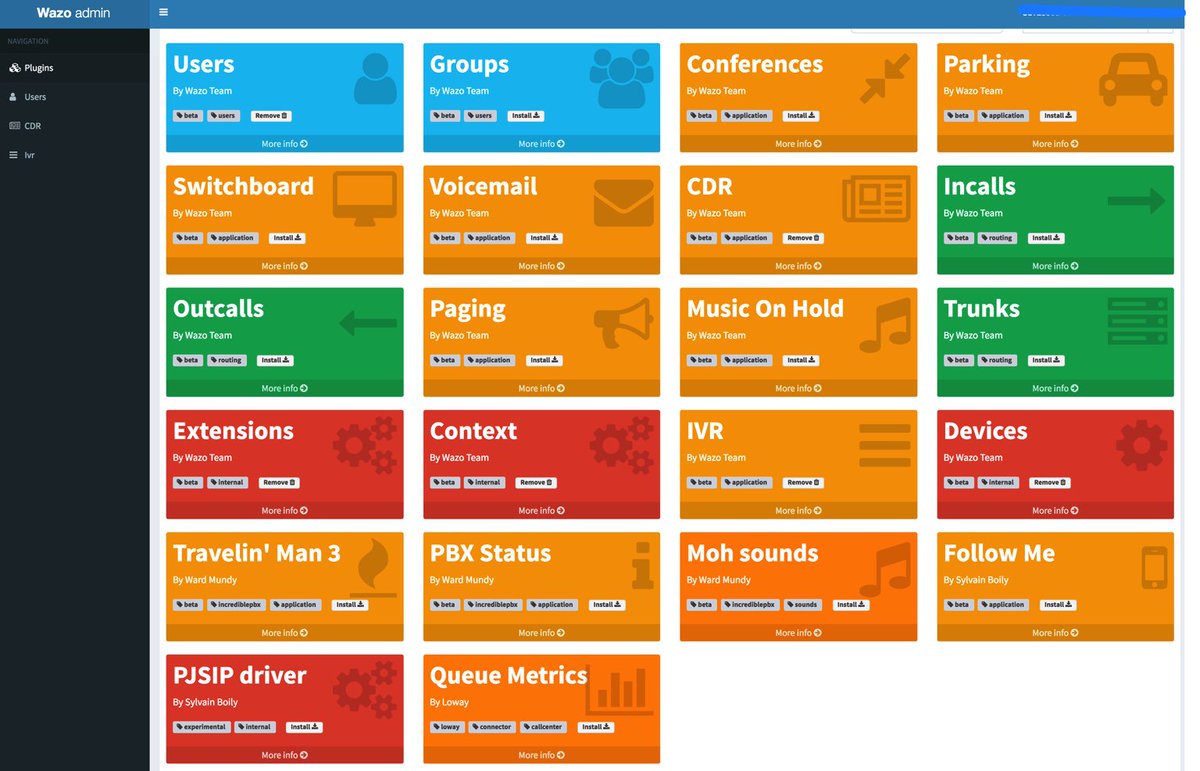
Wazo 17.17 enhances the brand new user interface to complement Wazo’s existing GUI. Revolutionary is probably the best way to describe its design. The reason is that it is generated using pure API calls to the Wazo engine. What that means to the administrator is you can tweak it, enhance it, replace it, or build additional functionality into your UI using the same API calls that the Wazo developers employed to build these components. This is obviously the first of many iterations that will be released in coming months, but it gives you an opportunity to kick the tires. Once you complete the installation process which follows, simply use a browser to log into the IP address of your server at the following link: https://serverIP/admin/. To begin, login with your root GUI credentials and click Plugins to display available options (pictured above). Then install each of the following plugins to begin: Users, Extensions, Contexts, and Devices. The remaining plugins are optional; however, the following plugins are not yet operational: Outcalls and Trunks. The Parking Lots and Switchboard plugins are functional but do not yet show existing setups configured through the legacy GUI. Additional tips and getting started tips are available here and here.
If you’ve been following along in our XiVO adventure with Incredible PBX last year, then you already know that there were a significant number of configuration hoops to jump through once the base install was finished. While these steps are well documented in the original Incredible PBX for XiVO tutorial, there still were plenty of opportunities for typos and skipping steps. Any misstep could spell the difference in a perfectly functioning PBX and one that couldn’t make or receive calls. So we introduced XiVO Snapshots, and today we bring the same technology to the Wazo platform as well.

A Wazo Snapshot is just what the name implies. It’s a snapshot of a working Wazo PBX that has virtually everything already configured: SIP settings that work with Asterisk®, a SIP extension that works with a SIP phone plus your cellphone, a SIP extension preconfigured for WebRTC that uses the new Opus codec, SIP and Google Voice trunk setups for many of the major commercial providers, and default inbound and outbound routes to ease the task of routing calls into and out of your PBX. Basically, you plug in your credentials from your favorite provider after running the Incredible PBX for Wazo installer, tell Wazo how to route the calls, and you’re done. You can have a stable and functional PBX making calls to anywhere in the world in a matter of minutes. Then you can review our numerous tutorials to add additional bells and whistles while actually using your Wazo PBX while you learn.
Incredible PBX for Wazo Installation Overview
Before we roll up our sleeves and walk you through the installation process, we wanted to provide a quick summary of the 10 Basic Steps in setting up Incredible PBX for Wazo. By the way, the whole process takes less than an hour!
- Set Up Desired PBX Platform: Stand-alone PC, Virtual Machine, or Cloud-Based Server
- Run the Incredible PBX for Wazo installer
- Set Up One or More SIP or Google Voice Trunks for Your PBX
- Tell Wazo Where to Direct Incoming Calls from Each Trunk
- Tell Wazo Which Trunk to Use for Every Outbound Calling Digit Sequence
- Set Up a SoftPhone or WebRTC Phone (or both)
- Decide Whether to Activate Simultaneous Ringing on your Cellphone
- Add Google Speech Recognition Key (if desired)
- Activate DISA with Incredible PBX for Wazo (if desired)
- Test Drive Incredible PBX for Wazo
1. Incredible PBX for Wazo Hardware Platform Setup
NOTE: Ignore references to Debian 9 in the platform setup tutorials. Debian 9 is not quite ready yet so stick with Debian 8.
The first step is to choose your hardware platform and decide whether you want to babysit a server and network or leave those tasks to others. We’ve taken the guesswork out of the setups documented below. Five of the options are cloud providers, each of whom provides a generous discount to let you kick the tires. So click on the links below to review the terms and our walkthrough of the setup process on each platform.
- Wazo Platform Tutorial: Installing Wazo on a Dedicated PC
- Wazo Platform Tutorial: Installing Wazo VM on VirtualBox
- Wazo Platform Tutorial: Installing Wazo VM on VMware ESXi
- Wazo Platform Tutorial: Installing Wazo VM at ImpactVPS
- Wazo Platform Tutorial: Installing Wazo VM at Vultr
- Wazo Platform Tutorial: Installing Wazo VM at OVH.com
- Wazo Platform Tutorial: Installing Wazo VM at Digital Ocean
- Wazo Platform Tutorial: Installing Wazo VM at WootHosting
- Wazo Platform Tutorial: Installing Wazo VM at CloudAtCost
- Wazo Platform Tutorial: Manually Installing Wazo and Debian 8
2. Running the Incredible PBX for Wazo Installer
Once you have your hardware platform up and running, the rest of the initial setup process is easy. Simply download and run the Incredible PBX for Wazo installer. On some platforms, it first updates Debian 8 to current specs and reboots. Then log back in and rerun the installer a second time if you are prompted to do so.
cd /root wget http://incrediblepbx.com/IncrediblePBX15-Wazo.sh chmod +x IncrediblePBX15-Wazo.sh ./IncrediblePBX15-Wazo.sh
3. Setting Up SIP and Google Voice Trunks with Wazo
When the installation is finished, you can make toll-free calls in the U.S. and Canada without doing anything except dialing "1″ and the 10-digit number from any phone connected to your server. For other calls, there are two steps in setting up trunks to use with Incredible PBX. First, you have to sign up with the provider of your choice and obtain trunk credentials. These typically include the FQDN of the provider’s server as well as your username and password to use for access to that server. Second, you have to configure a trunk on the Incredible PBX for Wazo server so that you can make or receive calls outside of your PBX. As with the platform tutorials, we have taken the guesswork out of the trunk setup procedure for roughly a dozen respected providers around the globe. In addition, Wazo Snapshots goes a step further and actually creates the trunks for you, minus your credentials, as part of the initial Incredible PBX install.
For Google Voice trunks with Incredible PBX 15, log into your server as root and run ./add-gvtrunk. When prompted, insert your 10-digit Google Voice number, your Google Voice email address and your OAuth 2 token. The native Google Voice OAuth tutorial explains how to obtain it.
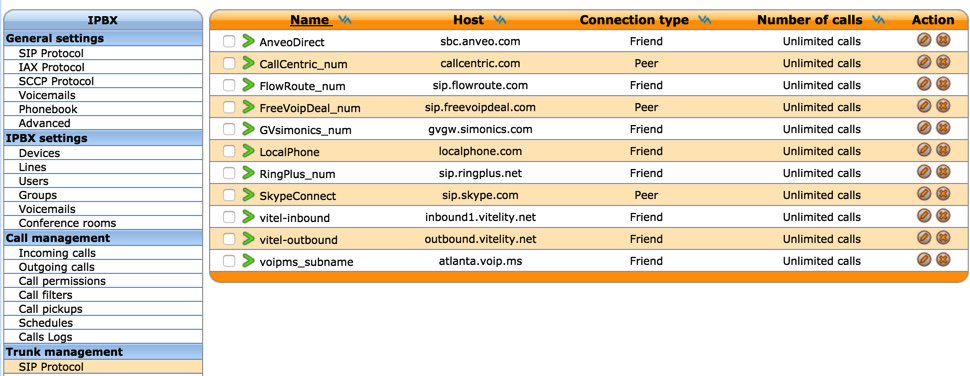
For the other providers, review the setup procedure below and then edit the preconfigured trunk for that provider by logging into the Wazo web GUI and choosing IPX → Trunk Management → SIP Protocol. Edit the setup for your provider (as shown above) and fill in your credentials and CallerID number in the General tab. Activate the trunk in the Register tab after again filling in your credentials. Save your settings when finished. No additional configuration for these providers is required using the Incredible PBX for Wazo Snapshot.
- Wazo Trunks Tutorial: Installing a Vitelity SIP Trunk
- Wazo Trunks Tutorial: Installing a VoIP.ms SIP Trunk
- Wazo Trunks Tutorial: Installing a RingPlus SIP Trunk
- Wazo Trunks Tutorial: Installing a FreeVoipDeal (Betamax) SIP Trunk
- Wazo Trunks Tutorial: Installing a Google Voice-Simonics SIP Trunk
- Wazo Trunks Tutorial: Deploying Native Google Voice with OAuth Trunks
- Wazo Trunks Tutorial: Installing an Anveo Direct Outbound SIP Trunk
- Wazo Trunks Tutorial: Installing a Skype Connect SIP Trunk
- Wazo Trunks Tutorial: Installing a LocalPhone SIP Trunk
- Wazo Trunks Tutorial: Installing a CallCentric SIP Trunk
- Wazo Trunks Tutorial: Installing a FlowRoute SIP Trunk
4. Directing Incoming Calls from Wazo Trunks
Registered Wazo trunks typically include a DID number. With the exception of CallCentric, this is the number that callers would dial to reach your PBX. With CallCentric, it’s the 11-digit account number of your account, e.g. 17771234567. In the Wazo web GUI, we use IPX → Call Management → Incoming Calls to create inbound routes for every DID and trunk associated with your PBX. Two sample DIDs have been preconfigured to show you how to route calls to an extension or to an IVR. To use these, simply edit their settings and change the DID to match your trunk. Or you can create new incoming routes to send calls to dozens of other destinations on your PBX.
5. Routing Outgoing Calls from Wazo to Providers
Outgoing calls from extensions on your Wazo PBX must be routed to a trunk provider to reach call destinations outside your PBX. Outgoing call routing is managed in IPX → Call Management → Outgoing Calls. You tell Wazo which trunk provider to use in the General tab. Then you assign a Calling Digit Sequence to this provider in the Exten tab. For example, if NXXNXXXXXX were assigned to Vitelity, this would tell Wazo to send calls to Vitelity if the caller dialed a 10-digit number. Wazo has the flexibility to add and remove digits from a dialed number as part of the outbound call routing process. For example, you might want callers to dial 48NXXNXXXXXX to send calls to a Google Voice trunk where 48 spells "GV" on the phone keypad. We obviously don’t want to send the entire dial string to Google Voice so we tell Wazo to strip the first 2 digits (48) from the number before routing the call out your Google Voice trunk. We’ve included two examples in the Wazo Snapshot to get you started. Skype Connect (shown below) is an example showing how to strip digits and also add digits before sending a call on its way:

6. Setting Up a Softphone & WebRTC with Wazo
If you’re a Mac user, you’re lucky (and smart). Download and install Telephone from the Mac App Store. Start up the application and choose Telephone:Preference:Accounts. Click on the + icon to add a new account. To set up your softphone, you need 3 pieces of information: the IP address of your server (Domain), and your Username and Password. In the World of Wazo, you’ll find these under IPBX → Services → Lines. Just click on the Pencil icon beside the extension to which you want to connect. Now copy or cut-and-paste your Username and Password into the Accounts dialog of the Telephone app. Click Done when you’re finished, and your new softphone will come to life and should show Available. Dial the IVR (4871) to try things out. With Telephone, you can use over two dozen soft phones simultaneously on your desktop.
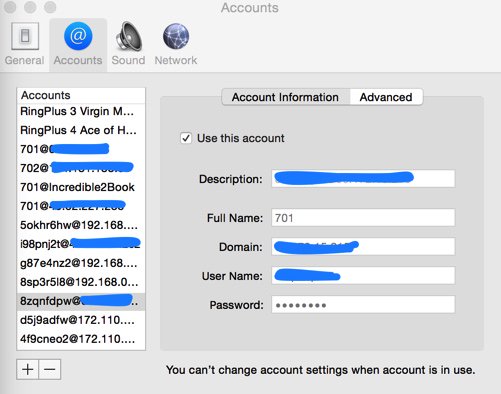
For everyone else, we recommend the YateClient softphone which is free. Download it from here. Run YateClient once you’ve installed it and enter the credentials for the Wazo Line. You’ll need the IP address of your server plus your Line username and password associated with the 701 extension. On the Wazo platform, do NOT use an actual extension number for your username with Wazo. Go to IPBX Settings → Lines to decipher the appropriate username and password for the desired extension. Click OK to save your entries.
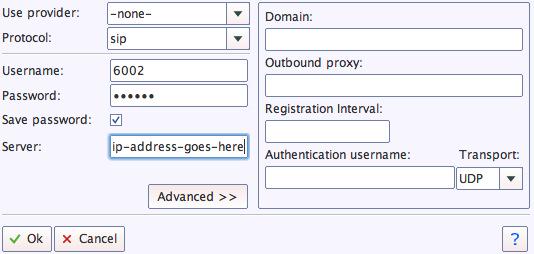
WebRTC allows you to use your Chrome or Firefox browser as a softphone. Extension 701 comes preconfigured for WebRTC access with Incredible PBX for Wazo. It shares the same password as the Line associated with extension 701, but the username is 701 rather than the username associated with the Line. You can decipher the password by accessing the Wazo Web GUI and then IPBX → Services → Users → Incredible PBX → XiVO Client Password. Or log into your server as root using SSH or Putty and run: /root/show-701-pw. Wazo introduces several new features to WebRTC including support for the awesome new Opus codec plus voicemail management and even Gravatar support. It’s all preconfigured!
Special Note: Beginning with version 17.02 of Wazo, WebRTC is fully integrated with NGINX on your server, and a simplified method for configuring WebRTC users has been added. When you create a new User account, simply choose the SIP (WebRTC) Protocol when creating a new user account, and all of the Advanced Line options required to support WebRTC will be preconfigured for you.

To use WebRTC, you no longer need to accept the different SSL certificates associated with the WebRTC app. From your browser, go to the following site and click on each link to accept the certificates. Once you’ve completed this process, simply visit the Wazo WebRTC site.
Before logging in, click on the Gear icon in the lower right corner and then click on the Pencil icon to edit your Settings. Fill in the public IP address of your Wazo server and specify 443 for the Port. Leave the Backend field blank and click Save. Now login to your WebRTC account with Username 701. The Password is the one you obtained running show-701-pw. The IP Address (if required) is the address of your Wazo PBX.
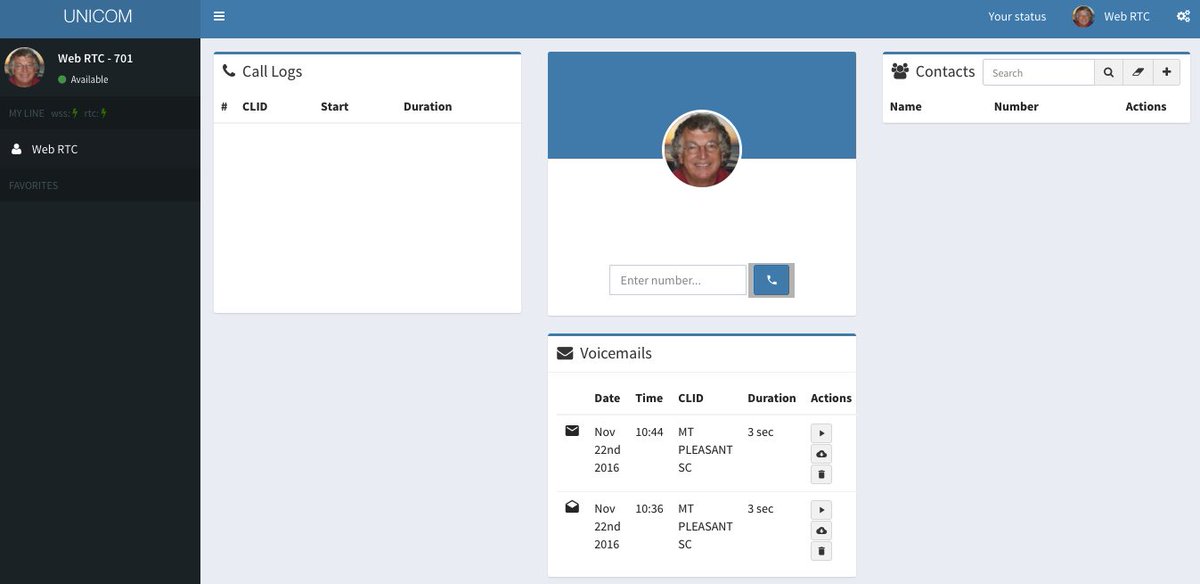
Implementing FollowMe Roaming with a CellPhone
In addition to ringing your SIP extension when incoming calls arrive, Wazo 17.17 can also ring your cellphone simultaneously. This obviously requires at least one outbound trunk. If that trunk provider also supports CallerID spoofing, then Wazo will pass the CallerID number of the caller rather than the DID associated with the trunk. Incredible PBX for Wazo comes with cellphone support for extension 702 ready to go. To enable it, access the Wazo Web GUI and go to IPBX → Services → Users → Incredible PBX and insert your Mobile Phone Number using the same dial string format associated with the trunk you wish to use to place the calls to your cellphone. You then can answer the incoming calls on either your cellphone or the registered SIP phone. If you answer on your cellphone, you will be prompted whether you wish to accept the call. If you press 1 after observing the CallerID, the caller will be connected. If you decline, the caller will be routed to the Wazo voicemail account of the extension.
8. Activating Voice Recognition for Wazo
Google has changed the licensing of their speech recognition engine about as many times as you change diapers on a newborn baby. Today’s rule restricts use to “personal and development use.” Assuming you qualify, the very first order of business is to enable speech recognition for your Wazo PBX. Once enabled, the Incredible PBX feature set grows exponentially. You’ll ultimately have access to the Voice Dialer for AsteriDex, Worldwide Weather Reports where you can say the name of a city and state or province to get a weather forecast for almost anywhere, Wolfram Alpha for a Siri-like encyclopedia for your PBX, and Lefteris Zafiris’ speech recognition software to build additional Asterisk apps limited only by your imagination. And, rumor has it, Google is about to announce new licensing terms, but we’re not there yet. To try out the Voice Dialer in today’s demo IVR, you’ll need to obtain a license key from Google. This Nerd Vittles tutorial will walk you through that process. Add your key to /var/lib/asterisk/agi-bin/speech-recog.agi on line 72.
9. Adding DISA Support to Your Wazo PBX
If you’re new to PBX lingo, DISA stands for Direct Inward System Access. As the name implies, it lets you make calls from outside your PBX using the call resources inside your PBX. This gives anybody with your DISA credentials the ability to make calls through your PBX on your nickel. It probably ranks up there as the most abused and one of the most loved features of the modern PBX.
There are three ways to implement DISA with Incredible PBX for Wazo. You can continue reading this section for our custom implementation with two-step authentication. There also are two native Wazo methods for implementing DISA using a PIN for security. First, you can dedicate a DID to incoming DISA calls. Or you can add a DISA option to an existing IVR. Both methods are documented in our tutorial on the PIAF Forum.
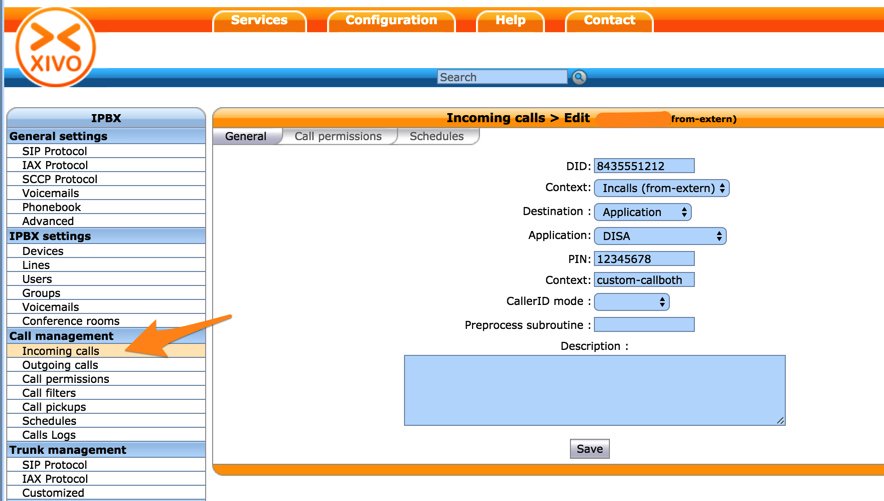
We prefer two-step authentication with DISA to make it harder for the bad guys. First, the outside phone number has to match the whitelist of numbers authorized to use your DISA service. And, second, you have to supply the DISA password for your server before you get dialtone to place an outbound call. Ultimately, of course, the monkey is on your back to create a very secure DISA password and to change it regularly. If all this sounds too scary, don’t install DISA on your PBX.
1. To get started, edit /root/disa-xivo.txt. When the editor opens the dialplan code, move the cursor down to the following line:
exten => 3472,n,GotoIf($["${CALLERID(number)}"="701"]?disago1) ; Good guy
2. Clone the line by pressing Ctrl-K and then Ctrl-U. Add copies of the line by pressing Ctrl-U again for each phone number you’d like to whitelist so that the caller can access DISA on your server. Now edit each line and replace 701 with the 10-digit number to be whitelisted.
3. Move the cursor down to the following line and replace 12341234 with the 8-digit numeric password that callers will have to enter to access DISA on your server:
exten => 3472,n,GotoIf($["${MYCODE}" = "12341234"]?disago2:bad,1)
4. Save the dialplan changes by pressing Ctrl-X, then Y, then ENTER.
5. Now copy the dialplan code into your Wazo setup, remove any previous copies of the code, and restart Asterisk:
cd /root sed -i '\:// BEGIN DISA:,\:// END DISA\:d' /etc/asterisk/extensions_extra.d/xivo-extrafeatures.conf cat disa-xivo.txt >> /etc/asterisk/extensions_extra.d/xivo-extrafeatures.conf /etc/init.d/asterisk reload
6. The traditional way to access DISA is to add it as an undisclosed option in an IVR that is assigned to one of your inbound trunks (DIDs). For the demo IVR that is installed, edit the ivr-1.conf configuration file and change the "option 0″ line so that it looks like this. Then SAVE your changes.
exten => 0,1(ivrsel-0),Dial(Local/3472@default)
7. Adjust the inbound calls route of one of your DIDs to point to the demo IVR by changing the destination to Customized with the following Command:
Goto(ivr-1,s,1)
A sample is included in the Wazo Snapshot. Here’s how ours looks for the Demo IVR:
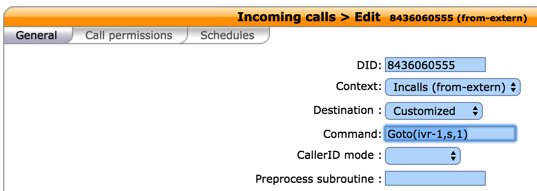
8. Now you should be able to call your DID and choose option 0 to access DISA assuming you have whitelisted the number from which you are calling. When prompted, enter the DISA password you assigned and press #. You then should be able to dial a 10-digit number to make an outside call from within your PBX.
SECURITY HINT: Whenever you implement a new IVR on your PBX, it’s always a good idea to call in from an outside number 13 TIMES and try every key from your phone to make sure there is no unanticipated hole in your setup. Be sure to also let the IVR timeout to see what result you get.
10. NEW: Travelin’ Man 3 WhiteList Firewall
All new installs of Incredible PBX for Wazo include the newly enhanced and preconfigured IPtables Firewall featuring Travelin’ Man 3. Please read the new tutorial when you have a few minutes. It documents how to enable access to your server for remote phones and traveling users.
PortKnocker previously let a remote user ping the server with a 3-digit code to temporarily add the remote user’s IP address to the IPtables Firewall WhiteList so that the user could gain remote access. We now are adding the ability to let end-users make successful PortKnocks permanent just as if an administrator had used add-ip on the server to add an IP address. Administrators still can remove these entries using del-acct although you will have to know the date and time that the entry was added. The file names consist of timestamp.iptables in /root and the additions are made to the custom WhiteList in /usr/local/sbin/iptables-custom. To enable permanent PortKnocker additions, simply run this command while logged into your server as root: iptables-knock activate.
11. Test Drive Incredible PBX for Wazo
To give you a good idea of what to expect with Incredible PBX for Wazo, just pick up a phone and dial any toll-free number in the U.S. and Canada using a 1 prefix. We’ve also set up a sample IVR using voice prompts from Allison. Try it out from any phone on your PBX by dialing 4871 (IVR1):
Nerd Vittles Demo IVR Options
1 – Call by Name (say "Delta Airlines" or "American Airlines" to try it out)
2 – MeetMe Conference
3 – Wolfram Alpha (Coming Soon!)
4 – Lenny (The Telemarketer’s Worst Nightmare)
5 – Today’s News Headlines
6 – Weather Forecast (enter a 5-digit ZIP code)
7 – Today in History (Coming Soon!)
8 – Speak to a Real Person (or maybe just Lenny if we’re out)
What To Do and Where to Go Next?
Here are a boatload of projects to get you started exploring Wazo on your own. Just plug the keywords into the search bar at the top of Nerd Vittles to find numerous tutorials covering the topics or simply follow our links. Unless there is an asterisk (*) the components already are in place so do NOT reinstall them. Just read the previous tutorials to learn how to configure each component. Be sure to also join the PIAF Forum to keep track of the latest tips and tricks with Wazo. There’s a treasure trove of information that awaits.
- Deploy Gmail as SMTP Relay for Wazo
- Build IVRs in Minutes
- Activate SMS Messaging
- Configure CallerID Superfecta
- Explore Munin Graphics in Wazo
- Integrate Google Calendar Alerts
- Configure NeoRouter and PPTP VPN
- Set Up EndPoint Management in Wazo
- Customize and Create New Wazo IVRs
- Try Out SQLite3 Call Detail Reports
- Learn About Wazo Backups and Upgrades
- Deploy SIP URIs for Free Worldwide Calling
- Develop a PortKnocker Emergency Access Plan
- Deploy Redundancy with Wazo High Availability
- * Install FCC RoboCall BlackList with WhiteList
- * Install Siri-Like Wolfram Alpha Module
- * Install Lenny, The Robocallers’ Worst Nightmare
Wazo and Incredible PBX Dial Code Cheat Sheets
Complete Wazo documentation is available here. But here are two cheat sheets in PDF format for Wazo Star Codes and Incredible PBX Dial Codes.
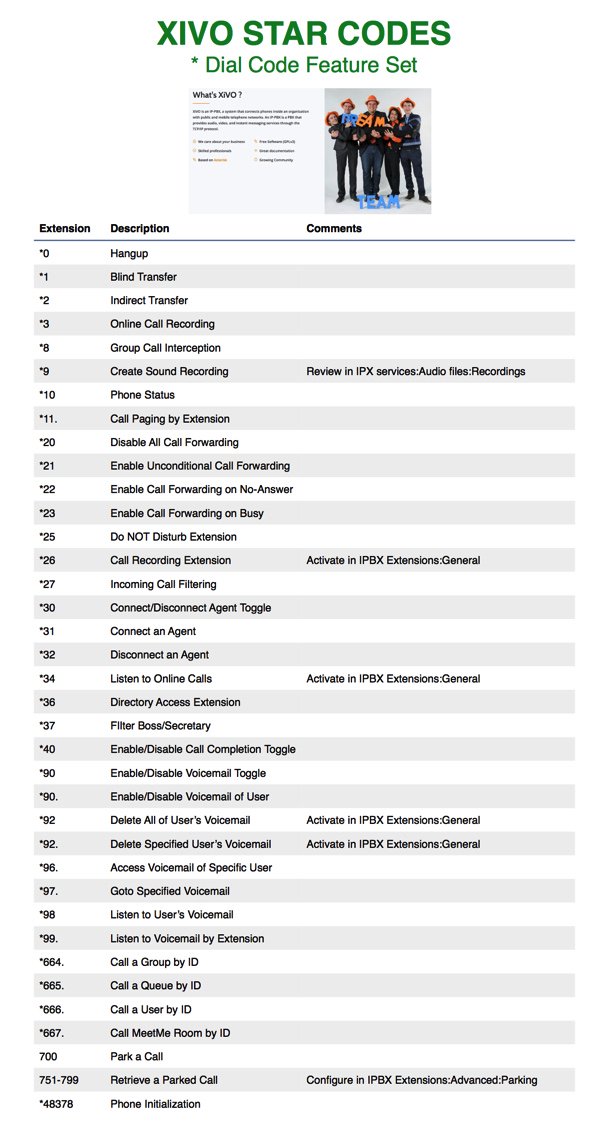

Published: Wednesday, December 14, 2016 Last Updated: Monday, December 12, 2017
 Don’t forget to List Yourself in Directory Assistance so everyone can find you by dialing 411. And add your new number to the Do Not Call Registry to block telemarketing calls. Or just call 888-382-1222 from your new number.
Don’t forget to List Yourself in Directory Assistance so everyone can find you by dialing 411. And add your new number to the Do Not Call Registry to block telemarketing calls. Or just call 888-382-1222 from your new number.

Need help with Asterisk? Visit the PBX in a Flash Forum.
Special Thanks to Our Generous Sponsors
FULL DISCLOSURE: ClearlyIP, Skyetel, Vitelity, DigitalOcean, Vultr, VoIP.ms, 3CX, Sangoma, TelecomsXchange and VitalPBX have provided financial support to Nerd Vittles and our open source projects through advertising, referral revenue, and/or merchandise. As an Amazon Associate and Best Buy Affiliate, we also earn from qualifying purchases. We’ve chosen these providers not the other way around. Our decisions are based upon their corporate reputation and the quality of their offerings and pricing. Our recommendations regarding technology are reached without regard to financial compensation except in situations in which comparable products at comparable pricing are available from multiple sources. In this limited case, we support our sponsors because our sponsors support us.
 BOGO Bonaza: Enjoy state-of-the-art VoIP service with a $10 credit and half-price SIP service on up to $500 of Skyetel trunking with free number porting when you fund your Skyetel account. No limits on number of simultaneous calls. Quadruple data center redundancy. $25 monthly minimum spend required. Tutorial and sign up details are here.
BOGO Bonaza: Enjoy state-of-the-art VoIP service with a $10 credit and half-price SIP service on up to $500 of Skyetel trunking with free number porting when you fund your Skyetel account. No limits on number of simultaneous calls. Quadruple data center redundancy. $25 monthly minimum spend required. Tutorial and sign up details are here.
 The lynchpin of Incredible PBX 2020 and beyond is ClearlyIP components which bring management of FreePBX modules and SIP phone integration to a level never before available with any other Asterisk distribution. And now you can configure and reconfigure your new Incredible PBX phones from the convenience of the Incredible PBX GUI.
The lynchpin of Incredible PBX 2020 and beyond is ClearlyIP components which bring management of FreePBX modules and SIP phone integration to a level never before available with any other Asterisk distribution. And now you can configure and reconfigure your new Incredible PBX phones from the convenience of the Incredible PBX GUI.
 VitalPBX is perhaps the fastest-growing PBX offering based upon Asterisk with an installed presence in more than 100 countries worldwide. VitalPBX has generously provided a customized White Label version of Incredible PBX tailored for use with all Incredible PBX and VitalPBX custom applications. Follow this link for a free test drive!
VitalPBX is perhaps the fastest-growing PBX offering based upon Asterisk with an installed presence in more than 100 countries worldwide. VitalPBX has generously provided a customized White Label version of Incredible PBX tailored for use with all Incredible PBX and VitalPBX custom applications. Follow this link for a free test drive!
 Special Thanks to Vitelity. Vitelity is now Voyant Communications and has halted new registrations for the time being. Our special thanks to Vitelity for their unwavering financial support over many years and to the many Nerd Vittles readers who continue to enjoy the benefits of their service offerings. We will keep everyone posted on further developments.
Special Thanks to Vitelity. Vitelity is now Voyant Communications and has halted new registrations for the time being. Our special thanks to Vitelity for their unwavering financial support over many years and to the many Nerd Vittles readers who continue to enjoy the benefits of their service offerings. We will keep everyone posted on further developments.

A New Day for 3CX: Free Text-to-Speech Apps from Santa

And you thought you needed an Asterisk® PBX for your users to enjoy GPL1 text-to-speech applications such as current News Headlines and Weather reports from the convenience of their telephone. Well, move over Asterisk. PIAF5™ and 3CX® now offer virtually identical functionality with all of the terrific advantages that a commercial-quality PBX provides: reliability, support, updates, security, and an unmatched UC platform that is second to none.
There is no 3CX support for interactive TTS or STT applications (yet). So we’re doing the next best thing. Once or more a day, we will use cron jobs to retrieve the latest News Headlines and Weather reports for your local area. Then anyone on your 3CX PBX can pick up a phone and listen to the News Headlines by dialing 951 or U.S. weather forecasts by dialing 947, or worldwide weather forecasts from ApiXU by dialing 949. We’ll be using IBM’s awesome TTS engine to handle the text-to-speech chores. We think you will agree that IBM’s offering is the best in the business. And you can’t beat the price. After your first free month, you get a million characters of FREE text-to-speech synthesis every month forever! For ApiXU worldwide weather data, your first 2,500 queries from 3CX are also FREE every month.
[soundcloud url="https://api.soundcloud.com/tracks/364353344″ params="auto_play=false&hide_related=false&show_comments=true&show_user=true&show_reposts=false&visual=true" width="80%" height="350″ iframe="true" /]
Getting Started with IBM Bluemix TTS Service
NOV. 1 UPDATE: IBM has moved the goal posts effective December 1, 2018:

You can start your free, 30-day trial of IBM Bluemix services without providing a credit card. Just sign up here. Once your account is activated, here’s how to obtain credentials for the TTS service to use with PIAF5 and 3CX. Start by logging in to your IBM Bluemix account. Once you’re logged in, click on your account name (1) in the upper right corner of your web page to reveal the pull-down to select your Region, Organization, and Space. Follow the blue links at the bottom of the pull-down menu to create an Organization and Space for your TTS service.
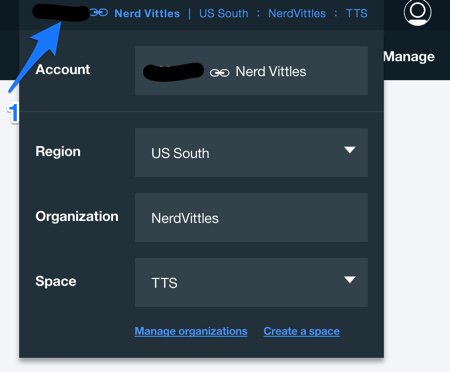
Next, click the Menu icon which is displayed as three horizontal bars on the left side of the web page. Choose Watson. Click Create Watson Service and select Text to Speech from the applications listing. Watson will generate a new TTS service template and display it. Make certain that your Region, Organization, and Space are shown correctly. Then verify that the Standard Pricing Plan is selected. When everything is correct, click the Create button.
When your Text to Speech application displays, click Service Credentials and then click New Credential (+). When the Add New Credential dialog appears, leave the default settings as they are and click Add. Your Credentials Listing then will appear. Click View Credentials beside the new entry you just created. Write down your URL, username, and password. You’ll need these in Step #4 below to configure the IBM Bluemix TTS service. Logout of the IBM Cloud by clicking on the little face in the upper right corner of your browser window and choose Log Out. Confirm that you do, indeed, wish to log out.
Getting Started with ApiXU Weather
Finding free worldwide weather forecasts has been a difficult nut to crack. So we’re pleased to introduce ApiXU. Your first 5,000 API calls every month are free, but our Worldwide Weather application for 3CX actually makes two API calls to retrieve the latest weather conditions AND the weather forecast. What that means is you can make 2,500 free queries a month with the Nerd Vittles application. One or two a day should suffice. While the U.S. weather reports are retrieved by ZIP code, the ApiXU queries are retrieved by city. So long as you don’t choose small towns, the city names should be sufficiently unique to work well with the WorldWide Weather application. HINT: Nicosia in Cyprus (home of 3CX) works great! 😉
Before you can obtain worldwide weather reports, you’ll need to sign up for an account at ApiXU.com. Once you’re registered, log into your account and copy down your API Key. You’ll need it in a minute.
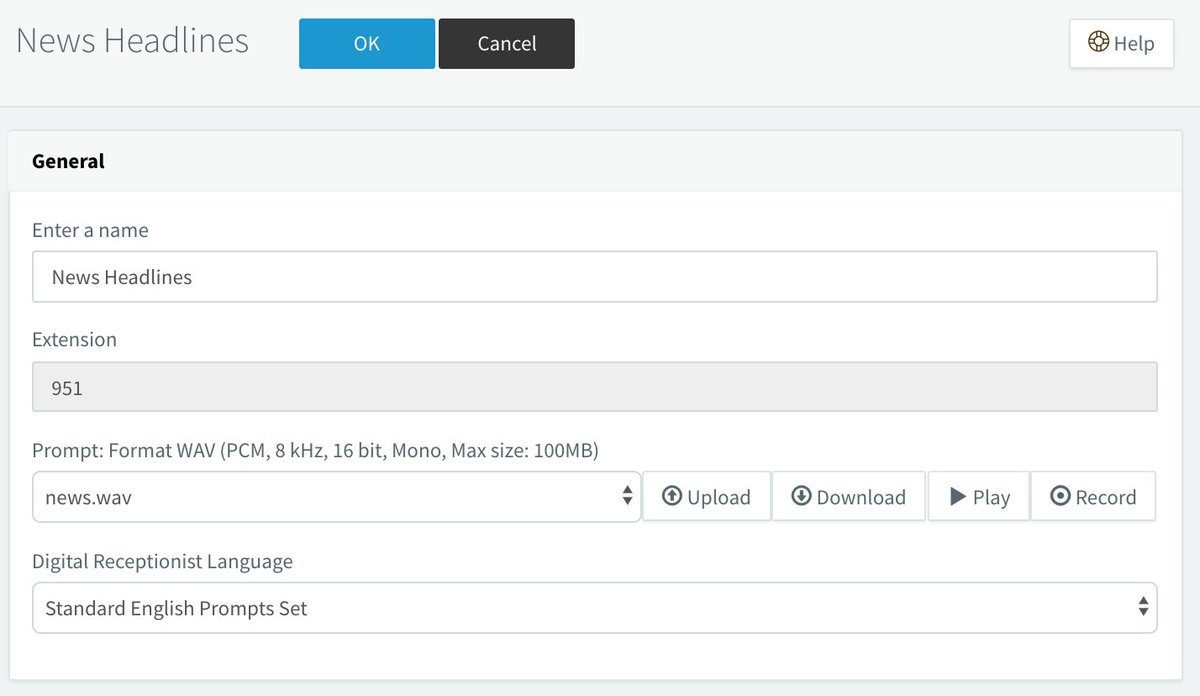
5 Steps to TTS Paradise with 3CX
Once you have your IBM TTS credentials in hand, there are only five simple steps to get everything set up for TTS application support on your 3CX PBX. When we’re finished, anyone on your 3CX PBX can pick up a phone and listen to the News Headlines by dialing 951, a U.S. Weather Forecast by dialing 947, or Worldwide Weather for most international cities by dialing 949.
- Download WAV file placeholders to your Desktop PC
- Set up 3 Digital Receptionists on your 3CX Dashboard
- Install the Linux components to support TTS Applications
- Insert IBM and ApiXU Credentials, Email Address and Locations
- Run the News Headlines and Weather Update Scripts
1. Downloading WAV File Placeholders
On the desktop computer from which you will access the 3CX Dashboard with a browser, download and unzip http://incrediblepbx.com/3cx-tts-desktop.zip. This gets you the three WAV files that we will use as placeholders in 3CX to support current News Headlines and Weather reports.
2. Setting Up Digital Receptionists in 3CX
Before you can implement the Nerd Vittles TTS Apps for News Headlines, Weather by ZIP Code, and Worldwide Weather, we first need to create the proper environment on the 3CX side to support the new applications. We’ll be using the 3CX Digital Receptionist for this purpose, and we’ll make one adjustment to the IVR environment to support scripted updates. First, we need to disable caching of sound prompts since we’ll be updating these every day, and we don’t want to have to reload the 3CX IVR module each time we make changes. Then we need to set up three Digital Receptionist extensions, one for the News Headlines and one for each of the Weather applications.
Login to your 3CX Dashboard with a browser.
First, we need to add a hidden environment variable to the 3CX Parameters Table to disable caching of IVR sound files. Here’s how.
From the 3CX Dashboard, choose Settings, then Parameters, and click Add. Insert the following new entry to the Parameters Table and then click OK:
Name: IVR_CACHE_DISABLE Description: Disable IVR caching of sound files Value: 1
Now let’s add the Digital Receptionists to support the News and Weather applications. From the 3CX Dashboard, choose Digital Receptionist then Add. Fill in the blanks like this:
Name: News Headlines
Extension: 951
Prompt: news.wav (then click Upload and choose news.wav file that you downloaded in step #1 to your Desktop)
skip down toward the bottom of the template and change If no input within seconds: to 1.
Click OK to save the News Headlines Digital Receptionist.
From the 3CX Dashboard, choose Digital Receptionist then Add. Fill in the blanks like this:
Name: Weather by ZIP Code
Extension: 947
Prompt: weather.wav (then click Upload and choose weather.wav file that you downloaded in step #1 to your Desktop)
skip down toward the bottom of the template and change If no input within seconds: to 1.
Click OK to save the Weather by ZIP Code Digital Receptionist.
Name: Worldwide Weather
Extension: 949
Prompt: wwweather.wav (then click Upload and choose wwweather.wav file that you downloaded in step #1 to your Desktop)
skip down toward the bottom of the template and change If no input within seconds: to 1.
Click OK to save the Worldwide Weather Digital Receptionist.
Try things out by dialing 947, 949, and 951 from any 3CX extension. Be sure these work before proceeding!
3. Installing Linux Components for TTS
First, we need to get the missing pieces in place to support TTS applications using IBM Bluemix TTS and the Nerd Vittles scripts. We want to add PHP support from the Linux CLI only so there will be no security issues. And we want to add support for SQLite 3 so we can look up latitude and longitude data for U.S. zip codes. Just issue the following commands to get everything set up:
apt-get update apt-get -y install php-fpm php-curl php-cli php-pear php-db php-gd sqlite3 libsqlite3-dev apt-get -y install sox lame libsox-fmt-mp3 sed -i 's|;cgi.fix_pathinfo=1|cgi.fix_pathinfo=0|' /etc/php/7.0/fpm/php.ini systemctl restart php7.0-fpm
Next, we need to put the Nerd Vittles scripts and ZIP code database for SQLite 3 in place:
cd / wget http://incrediblepbx.com/3cx-tts-linux.tar.gz tar zxvf 3cx-tts-linux.tar.gz rm -f 3cx-tts-linux.tar.gz
Finally, we need to add cron jobs to run the three update scripts at least once a day. You can run them more often depending upon your needs. We have these configured to run at 6:15 am and 6:20 am every day. Adjust to meet your own requirements. To update the cached voice prompts, each of these update scripts stops and restarts the 3CX IVR Service. On a busy PBX, you probably don’t want to run them during the workday.
echo "15 6 * * * root /root/nv-weather-update.sh >/dev/null 2>&1" >> /etc/crontab echo "20 6 * * * root /root/nv-news-update.sh >/dev/null 2>&1" >> /etc/crontab echo "25 6 * * * root /root/nv-wwweather-update.sh >/dev/null 2>&1" >> /etc/crontab
4. Adding TTS Credentials to Your 3CX PBX
Now we need to add your IBM TTS and ApiXU credentials, email address, a local ZIP code for Weather by ZIP code reports, and a city for Worldwide Weather reports. Edit the credentials file and save it with your information:
cd /root nano -w ibm-credentials.php
5. Running the News & Weather Update Scripts
Finally, we need to run the News Headlines and two Weather update scripts once to put current data in place for 3CX callers. After the initial setup, the cron jobs will update the News Headlines and Weather reports every day moving forward. Press ENTER as each of the scripts finishes to get back to a command prompt.
cd /root ./nv-news-update.sh ./nv-weather-update.sh ./nv-wwweather-update.sh
Taking the News & Weather Apps for a Spin
Now you’re ready to try things out. From any phone connected to your 3CX, dial 951 for current News Headlines. Then dial 947 for a local Weather Report matching your zip code. Finally, dial 949 to retrieve a worldwide weather forecast for most international cities. Enjoy!
Originally published: Monday, December 4, 2017 Updated: Friday, March 2, 2018
 Support Issues. With any application as sophisticated as this one, you’re bound to have questions. Blog comments are a terrible place to handle support issues although we welcome general comments about our articles and software. If you have particular support issues, we encourage you to get actively involved in the PBX in a Flash Forums. It’s the best Asterisk tech support site in the business, and it’s all free! Please have a look and post your support questions there. Unlike some forums, ours is extremely friendly and is supported by literally hundreds of Asterisk and 3CX gurus and thousands of users just like you. You won’t have to wait long for an answer to your question.
Support Issues. With any application as sophisticated as this one, you’re bound to have questions. Blog comments are a terrible place to handle support issues although we welcome general comments about our articles and software. If you have particular support issues, we encourage you to get actively involved in the PBX in a Flash Forums. It’s the best Asterisk tech support site in the business, and it’s all free! Please have a look and post your support questions there. Unlike some forums, ours is extremely friendly and is supported by literally hundreds of Asterisk and 3CX gurus and thousands of users just like you. You won’t have to wait long for an answer to your question.

Need help with Asterisk or 3CX? Visit the PBX in a Flash Forum.
Special Thanks to Our Generous Sponsors
FULL DISCLOSURE: ClearlyIP, Skyetel, Vitelity, DigitalOcean, Vultr, VoIP.ms, 3CX, Sangoma, TelecomsXchange and VitalPBX have provided financial support to Nerd Vittles and our open source projects through advertising, referral revenue, and/or merchandise. As an Amazon Associate and Best Buy Affiliate, we also earn from qualifying purchases. We’ve chosen these providers not the other way around. Our decisions are based upon their corporate reputation and the quality of their offerings and pricing. Our recommendations regarding technology are reached without regard to financial compensation except in situations in which comparable products at comparable pricing are available from multiple sources. In this limited case, we support our sponsors because our sponsors support us.
 BOGO Bonaza: Enjoy state-of-the-art VoIP service with a $10 credit and half-price SIP service on up to $500 of Skyetel trunking with free number porting when you fund your Skyetel account. No limits on number of simultaneous calls. Quadruple data center redundancy. $25 monthly minimum spend required. Tutorial and sign up details are here.
BOGO Bonaza: Enjoy state-of-the-art VoIP service with a $10 credit and half-price SIP service on up to $500 of Skyetel trunking with free number porting when you fund your Skyetel account. No limits on number of simultaneous calls. Quadruple data center redundancy. $25 monthly minimum spend required. Tutorial and sign up details are here.
 The lynchpin of Incredible PBX 2020 and beyond is ClearlyIP components which bring management of FreePBX modules and SIP phone integration to a level never before available with any other Asterisk distribution. And now you can configure and reconfigure your new Incredible PBX phones from the convenience of the Incredible PBX GUI.
The lynchpin of Incredible PBX 2020 and beyond is ClearlyIP components which bring management of FreePBX modules and SIP phone integration to a level never before available with any other Asterisk distribution. And now you can configure and reconfigure your new Incredible PBX phones from the convenience of the Incredible PBX GUI.
 VitalPBX is perhaps the fastest-growing PBX offering based upon Asterisk with an installed presence in more than 100 countries worldwide. VitalPBX has generously provided a customized White Label version of Incredible PBX tailored for use with all Incredible PBX and VitalPBX custom applications. Follow this link for a free test drive!
VitalPBX is perhaps the fastest-growing PBX offering based upon Asterisk with an installed presence in more than 100 countries worldwide. VitalPBX has generously provided a customized White Label version of Incredible PBX tailored for use with all Incredible PBX and VitalPBX custom applications. Follow this link for a free test drive!
 Special Thanks to Vitelity. Vitelity is now Voyant Communications and has halted new registrations for the time being. Our special thanks to Vitelity for their unwavering financial support over many years and to the many Nerd Vittles readers who continue to enjoy the benefits of their service offerings. We will keep everyone posted on further developments.
Special Thanks to Vitelity. Vitelity is now Voyant Communications and has halted new registrations for the time being. Our special thanks to Vitelity for their unwavering financial support over many years and to the many Nerd Vittles readers who continue to enjoy the benefits of their service offerings. We will keep everyone posted on further developments.
Some Recent Nerd Vittles Articles of Interest…
- The included applications are licensed pursuant to GPL2 with the exception of nv-worldwide-weather.php which is licensed pursuant to The MIT License. Terms and conditions of both licenses are included in /root/COPYING. [↩]
The New Hybrid PBX: Why Settle for a One Trick Pony?

Let’s face it. It’s hard not to like the application development flexibility that Asterisk® offers, especially if you’re part of an organization that has very specific telephony needs. But the price you pay for "free" and putting all of your eggs in the Asterisk basket is painful. Here are a few of the hurdles that come to mind: security, NAT, one-way audio, remote users, CRM support, conferencing, painful upgrades to address frequent bug fixes, and, more generally, telephone management and support. We love Asterisk, but…
Most folks don’t buy all of their cars or groceries or computer software from a single company. So why do it with your phone system when you can take advantage of the best of all worlds, open source and commercial? To us, that’s the compelling case for integrating a 3CX commercial PBX into your Asterisk infrastructure. It’s a new iteration of what we used to call a hybrid PBX. And you can do it without cost for a full year to kick the 3CX tires and provide your mobile users with transparent phone service regardless of where they are roaming. Using the special Nerd Vittles signup link, you get a custom version of 3CX that supports 4 simultaneous calls, 10-user web meetings, unlimited trunks, and 10 or more extensions. After the first year, you can either spring for less than $100 a year to maintain the 3CX free PBX platform and mobile clients with pain-free updates, or you can upgrade to a more robust 3CX Pro commercial offering with a much expanded feature set including call center technology and seamless CRM integration with MS Exchange, Salesforce, Microsoft Dynamics, Microsoft Outlook, Office 365, Google Contacts, Exact Online, Freshdesk, Datev, Zendesk, Nutshell, vtiger, EBP, Insightly, amoCRM, Bitrix24 and Act. What’s not to like?
If you’re a frequent Nerd Vittles visitor, you already know that the 3CX clients for iOS, Android, Windows, and Macs are one of our favorite telephony apps of all time. The ease with which the 3CX client can be configured with a single click on an email attachment is revolutionary. And, once configured, the fact that you never again experience a NAT problem with a SIP call is nothing short of miraculous. As we’ve previously mentioned, the 3CX Client provides a nearly perfect mobile client for those that rely upon Asterisk. Now 3CX is poised to release an even easier configuration procedure for their mobile clients in update 2 for version 15.5. Simply log into your 3CX web client on a PC or Mac and choose the Settings:QR Code option from the menu bar. 3CX will present a QR code to activate the 3CX Client for your smartphone. Scan it using the 3CX Client app on your smartphone and, presto, your phone is instantly provisioned. It doesn’t get any easier than this…
Let’s spend a little time reviewing our favorite Hybrid PBX setup. In this scenario which is perfect for small businesses with a mobile workforce, the setup looks like this. An Asterisk server is deployed to manage company trunks including Google Voice, voicemail, IVRs, custom apps, and extensions for every employee. Then we add a 3CX free PBX, interconnect it with the Asterisk PBX, and assign a 3CX extension for every employee. The 3CX extensions will all tie back to the employee extensions on the Asterisk PBX. It obviously simplifies things if you keep your number schemes consistent. For example, extension 7000 on the Asterisk PBX could be matched to extension 000 on the 3CX PBX. Then we set up outbound trunks on both the Asterisk PBX and 3CX to dial a 9 prefix to reach extensions on the other PBX. So dialing 9000 on the Asterisk PBX would connect the caller to extension 000 on the 3CX PBX. On the 3CX side, dialing 9000 would connect the caller to extension 7000 on the Asterisk PBX in our example. And, of course, 3CX Clients can reach any number worldwide using Asterisk outbound trunks by dialing a 9 prefix and then the long distance number. Our previous tutorials will walk you through setting this up with Incredible PBX® 13, Issabel™, any FreePBX®-based PBX, or even Wazo. Once you complete the 5-minute setup, mobile users can take advantage of all the powerful features on any 3CX Client platform while still receiving their incoming calls from the Asterisk-based office PBX by simply forwarding their extension to their matching 9XXX destination on the 3CX platform. This will ring their 3CX Client anywhere in the world with nothing but a Wi-Fi connection! And it’s a free call.
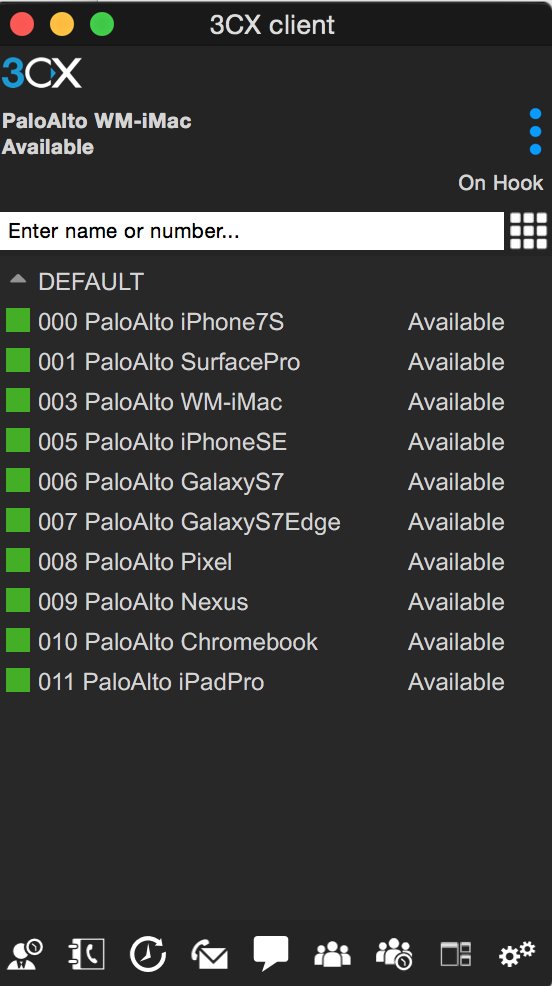
Published: Monday, October 16, 2017

Need help with Asterisk? Visit the PBX in a Flash Forum.
Special Thanks to Our Generous Sponsors
FULL DISCLOSURE: ClearlyIP, Skyetel, Vitelity, DigitalOcean, Vultr, VoIP.ms, 3CX, Sangoma, TelecomsXchange and VitalPBX have provided financial support to Nerd Vittles and our open source projects through advertising, referral revenue, and/or merchandise. As an Amazon Associate and Best Buy Affiliate, we also earn from qualifying purchases. We’ve chosen these providers not the other way around. Our decisions are based upon their corporate reputation and the quality of their offerings and pricing. Our recommendations regarding technology are reached without regard to financial compensation except in situations in which comparable products at comparable pricing are available from multiple sources. In this limited case, we support our sponsors because our sponsors support us.
 BOGO Bonaza: Enjoy state-of-the-art VoIP service with a $10 credit and half-price SIP service on up to $500 of Skyetel trunking with free number porting when you fund your Skyetel account. No limits on number of simultaneous calls. Quadruple data center redundancy. $25 monthly minimum spend required. Tutorial and sign up details are here.
BOGO Bonaza: Enjoy state-of-the-art VoIP service with a $10 credit and half-price SIP service on up to $500 of Skyetel trunking with free number porting when you fund your Skyetel account. No limits on number of simultaneous calls. Quadruple data center redundancy. $25 monthly minimum spend required. Tutorial and sign up details are here.
 The lynchpin of Incredible PBX 2020 and beyond is ClearlyIP components which bring management of FreePBX modules and SIP phone integration to a level never before available with any other Asterisk distribution. And now you can configure and reconfigure your new Incredible PBX phones from the convenience of the Incredible PBX GUI.
The lynchpin of Incredible PBX 2020 and beyond is ClearlyIP components which bring management of FreePBX modules and SIP phone integration to a level never before available with any other Asterisk distribution. And now you can configure and reconfigure your new Incredible PBX phones from the convenience of the Incredible PBX GUI.
 VitalPBX is perhaps the fastest-growing PBX offering based upon Asterisk with an installed presence in more than 100 countries worldwide. VitalPBX has generously provided a customized White Label version of Incredible PBX tailored for use with all Incredible PBX and VitalPBX custom applications. Follow this link for a free test drive!
VitalPBX is perhaps the fastest-growing PBX offering based upon Asterisk with an installed presence in more than 100 countries worldwide. VitalPBX has generously provided a customized White Label version of Incredible PBX tailored for use with all Incredible PBX and VitalPBX custom applications. Follow this link for a free test drive!
 Special Thanks to Vitelity. Vitelity is now Voyant Communications and has halted new registrations for the time being. Our special thanks to Vitelity for their unwavering financial support over many years and to the many Nerd Vittles readers who continue to enjoy the benefits of their service offerings. We will keep everyone posted on further developments.
Special Thanks to Vitelity. Vitelity is now Voyant Communications and has halted new registrations for the time being. Our special thanks to Vitelity for their unwavering financial support over many years and to the many Nerd Vittles readers who continue to enjoy the benefits of their service offerings. We will keep everyone posted on further developments.
Some Recent Nerd Vittles Articles of Interest…
VoIP Security: Installing SSL Certificates with Incredible PBX

We’ve got some revolutionary VoIP projects coming your way over the next several weeks, but I’m sorry to say the hardest part of them is getting your server configured to use secure and encrypted web communications via HTTPS. This is quickly becoming a universal requirement of most of the major technology players. So what might not be the most glamorous VoIP topic for a Monday morning is not only necessary but long overdue. The good news is that obtaining, installing, configuring, and maintaining an SSL certificate for your VoIP server is not the royal pain that it once was. And, by this time next week, you’ll be glad you went through the exercise. Thankfully, the EFF’s Certbot project is available to assist in installing free certificates from Let’s Encrypt.
Before we begin, here’s a word to the wise. You will save yourself a thousand headaches by deploying your Incredible PBX server in the cloud where you get a dedicated IP address and can easily assign a fully-qualified domain name (FQDN) to your server. Options now are available for as little as $1.50 to $3.50/month including Vultr which provides an incredibly reliable platform in many cities for as little as $2.50 a month. And another 50¢ buys you weekly image backups without lifting a finger. They can be restored with one click! If reliability and redundancy matter, you can’t beat Vultr’s price or the feature set, and we have tutorials to get you started with either Wazo or Issabel. If cost is your sole criteria, you can’t beat WootHosting at $1.50 a month. You’ll find a tutorial here. If performance is critical, you can’t beat OVH at $3.50/month with a Wazo tutorial here and an Issabel tutorial here. Finally, if you’re technically challenged, our corporate sponsor, RentPBX, will do all of the cloud migration for you and provide a turnkey, high performance VoIP platform for just $15/month. So what are you waiting for? Now’s the time. No excuses! It’s not going to get any cheaper or more reliable. And next week you’ll be thanking us. For these reasons, we’re saying goodbye our home-based servers sitting behind NAT-based firewalls. With the projects coming down the pike, the mountain is just too steep to continue that trek unless you have the technical expertise to pull it off yourself.
Obtaining and Installing an SSL Certificate
For CentOS 6 running Incredible PBX 13 or CentOS 7 running Incredible PBX for Issabel 4, begin by making certain that you can access your site using its FQDN with HTTP, e.g. http://myserver.mydomain.org. Get that working first. Next, log into your server as root using SSH/Putty and issue the following commands:
yum -y install python-devel python-pip python-setuptools python-virtualenv --enablerepo=epel yum -y install centos-release-scl yum -y install python27 scl enable python27 bash pip -V # should show python 2.7 pip install --upgrade pip pip install requests registry urllib3 pyOpenSSL --force --upgrade pip install certbot-apache --force --upgrade cd /root wget https://dl.eff.org/certbot-auto chmod a+x certbot-auto service iptables stop ./certbot-auto --authenticator webroot --installer apache -w /var/www/html -d FQDN.here iptables-restart service httpd restart exit
During the automated setup, you can decide whether to force all web traffic to the secure site. We recommend it. Once the install finishes, test access to your server by going to your FQDN using HTTPS. Don’t continue with the setup until you get HTTPS working and your browser shows you have a SECURE site! Remember that you must renew your free certificate every 90 days by using the following /root/certbot-update script:
#!/bin/bash echo "Before you begin, type: scl enable python27 bash" echo "Then rerun this update script and press ENTER." read -p "If you already have done so, press Enter. Otherwise, Ctrl-C now" service iptables stop ./certbot-auto --authenticator webroot --installer apache -w /var/www/html -d FQDN.here iptables-restart echo "Type exit when this script completes." exit
For Debian 8 running Incredible PBX for Wazo, things are a bit more complicated because Wazo forces HTTPS access even though you do not yet have a certificate for your FQDN. Because of its NGINX web server platform, with Wazo you’ll have to manually install and configure certificates with certbot and LetsEncrypt. The silver lining with Wazo is HTTPS access gets you a WebRTC phone with a couple button clicks. Go to this link, click on the Config wheel (bottom right), click on the Pencil icon and plug in the FQDN of your server. Click SAVE. Enter your login name as 701 and the password assigned to the extension which you can obtain by running: /root/show-701-pw. That’s probably the quickest phone setup you’ll ever find. But we’re getting ahead of ourselves…
1. Let’s get certbot installed. Login to your server as root using SSH or Putty and issue the following commands:
cd /etc/apt echo "deb http://ftp.debian.org/debian jessie-backports main" >> sources.list apt-get update apt-get install certbot -t jessie-backports
2. Temporarily, turn off HTTPS since the certificate install requires HTTP access. In /etc/nginx/sites-enabled/xivo, comment out these 3 lines and save the updated file:
In server section for port 80: # include /etc/nginx/locations/http-enabled/*; In server section for port 443: # listen 443 default_server; # server_name $domain;
Then restart the web server: /etc/init.d/nginx restart. Now you have a basic http web server. If you want to verify that it’s working, use a browser and go to http://YOUR-FQDN/asteridex4/index.php. It should download the file to your desktop which isn’t desirable, but this is only temporary.
3. In /var/www/html, issue the following commands:
cd /var/www/html mkdir .well-known cd .well-known mkdir acme-challenge cd acme-challenge chown -R asterisk:www-data /var/www/html/.well-known
Leave this SSH/Putty session running temporarily and open a second SSH/Putty connection to your server logging in as root.
4. Disable your firewall temporarily: /etc/init.d/netfilter-persistent flush
5. Start the certbot installation script: certbot certonly –manual
6. You’ll be prompted for the FQDN of your server to generate the certificates. Then you’ll be given an oddball name AND an expected oddball response. With these two entries in hand, temporarily switch back to your other SSH session and issue these commands while positioned in /var/www/html/.well-known/acme-challenge:
mkdir ODDBALL-NAME cd ODDBALL-NAME echo "ODDBALL-RESPONSE > index.html" chown -R asterisk:www-data /var/www/html/.well-known
7. Use a browser to (quickly) go to http://YOUR-FQDN/.well-known/acme-challenge/ODDBALL-NAME/ and be sure your web server displays the expected ODDBALL-RESPONSE. You’ve got to get this working before you continue with the certbot install or it will fail. You only have a few minutes to do this before certbot will change the ODDBALL-NAME and ODDBALL-RESPONSE credentials. 3 consecutive failures and you have to wait an hour to try again. Guess how we know?
8. Once you get the expected response, switch back to your SSH session running the certbot installer and press ENTER to continue with the certificate install. When it completes, you’ll get a congratulatory note and a reminder that, in less than 90 days, you’ll need to run certbot renew to update your certificate.
9. Install the new certificates in NGINX and put things back together again:
cd /etc/nginx/sites-enabled nano -w xivo
10. Begin by removing the 3 # signs that we inserted to get HTTP working in step #2.
11. Near the bottom of the file, comment out these existing certificate lines:
# ssl_certificate /usr/share/xivo-certs/server.crt; # ssl_certificate_key /usr/share/xivo-certs/server.key; # ssl_ciphers ALL:!aNULL:!eNULL:!LOW:!EXP:!RC4:!3DES:!SEED:+HIGH:+MEDIUM;
12. Add the following new lines just below the lines you commented out. Be sure to replace YOUR.FQDN in each line with the actual FQDN of your server:
ssl_certificate /etc/letsencrypt/live/YOUR.FQDN/fullchain.pem;
ssl_certificate_key /etc/letsencrypt/live/YOUR.FQDN/privkey.pem;
ssl_ciphers HIGH:MEDIUM:!aNULL:!MD5:!SEED:!IDEA;
13. Save the file and then restart your firewall and NGINX:
iptables-restart /etc/init.d/nginx restart
14. Edit /etc/apt/sources.list and comment out the jessie-backports line from step #1.
15. Reload your aptitude sources: apt-get update
16. Remember that you must renew your free certificate every 90 days by issuing this command: certbot renew --quiet.
Better yet, issue the following command to set up a cron job to auto-renew your certificate every week:
echo "5 3 * * 0 root /usr/bin/certbot renew --quiet > /dev/null 2>&1" >> /etc/crontab
17. Test things out with a web browser by visiting your FQDN. Your browser should now show the site as SECURE.
18. Now try out that new WebRTC phone.
Published: Monday, September 25, 2017

Need help with Asterisk? Visit the PBX in a Flash Forum.
Special Thanks to Our Generous Sponsors
FULL DISCLOSURE: ClearlyIP, Skyetel, Vitelity, DigitalOcean, Vultr, VoIP.ms, 3CX, Sangoma, TelecomsXchange and VitalPBX have provided financial support to Nerd Vittles and our open source projects through advertising, referral revenue, and/or merchandise. As an Amazon Associate and Best Buy Affiliate, we also earn from qualifying purchases. We’ve chosen these providers not the other way around. Our decisions are based upon their corporate reputation and the quality of their offerings and pricing. Our recommendations regarding technology are reached without regard to financial compensation except in situations in which comparable products at comparable pricing are available from multiple sources. In this limited case, we support our sponsors because our sponsors support us.
 BOGO Bonaza: Enjoy state-of-the-art VoIP service with a $10 credit and half-price SIP service on up to $500 of Skyetel trunking with free number porting when you fund your Skyetel account. No limits on number of simultaneous calls. Quadruple data center redundancy. $25 monthly minimum spend required. Tutorial and sign up details are here.
BOGO Bonaza: Enjoy state-of-the-art VoIP service with a $10 credit and half-price SIP service on up to $500 of Skyetel trunking with free number porting when you fund your Skyetel account. No limits on number of simultaneous calls. Quadruple data center redundancy. $25 monthly minimum spend required. Tutorial and sign up details are here.
 The lynchpin of Incredible PBX 2020 and beyond is ClearlyIP components which bring management of FreePBX modules and SIP phone integration to a level never before available with any other Asterisk distribution. And now you can configure and reconfigure your new Incredible PBX phones from the convenience of the Incredible PBX GUI.
The lynchpin of Incredible PBX 2020 and beyond is ClearlyIP components which bring management of FreePBX modules and SIP phone integration to a level never before available with any other Asterisk distribution. And now you can configure and reconfigure your new Incredible PBX phones from the convenience of the Incredible PBX GUI.
 VitalPBX is perhaps the fastest-growing PBX offering based upon Asterisk with an installed presence in more than 100 countries worldwide. VitalPBX has generously provided a customized White Label version of Incredible PBX tailored for use with all Incredible PBX and VitalPBX custom applications. Follow this link for a free test drive!
VitalPBX is perhaps the fastest-growing PBX offering based upon Asterisk with an installed presence in more than 100 countries worldwide. VitalPBX has generously provided a customized White Label version of Incredible PBX tailored for use with all Incredible PBX and VitalPBX custom applications. Follow this link for a free test drive!
 Special Thanks to Vitelity. Vitelity is now Voyant Communications and has halted new registrations for the time being. Our special thanks to Vitelity for their unwavering financial support over many years and to the many Nerd Vittles readers who continue to enjoy the benefits of their service offerings. We will keep everyone posted on further developments.
Special Thanks to Vitelity. Vitelity is now Voyant Communications and has halted new registrations for the time being. Our special thanks to Vitelity for their unwavering financial support over many years and to the many Nerd Vittles readers who continue to enjoy the benefits of their service offerings. We will keep everyone posted on further developments.
Some Recent Nerd Vittles Articles of Interest…
RTPbleed Security Alert: Asterisk Calls Can Be Intercepted

If you’ve installed Asterisk® during the past 4½ years, your server has a MAJOR security problem. If you didn’t already know, with Asterisk, your VoIP conversations actually are carried over a random UDP port using the Real Time Protocol (RTP), not the SIP port (UDP 5060) which handles the setup and teardown of your VoIP connections. It turns out that, since March 2013, all of that RTP traffic and thus your conversations could be intercepted and redirected by anyone on the Internet. As this recent article in The Register noted:
The problem occurs when [communications] systems like IP telephony have to get past network address translation (NAT) firewalls. The traffic has to find its way from the firewall’s public IP address to the internal address of the device or server, and to do that, RTP learns the IP and port addresses to associate with a call.
The problem is, the process doesn’t use any kind of authentication.
This is exacerbated by the fact that, by default, Asterisk and FreePBX® traditionally use the NAT=yes setting (whether needed or not) to enable this navigational magic just in case your calls need it. Without it, you may end up with no audio or one-way audio on your calls. Traditional wisdom was that an attacker needed to be positioned between the caller and the Asterisk server in order to intercept this media stream. As luck would have it, it turns out the man in the middle didn’t need to be in the middle after all. He could be anywhere on the Internet. The old adage to talk on the phone as if someone else were listening turns out to have been pretty good advice in the case of Asterisk communications. Even if you had a firewall, chances are you protected UDP port 5060 while exposing and forwarding UDP 10000-20000 to Asterisk without any safeguards.
According to last week’s Asterisk advisory, “To exploit this issue, an attacker needs to send RTP packets to the Asterisk server on one of the ports allocated to receive RTP. When the target is vulnerable, the RTP proxy responds back to the attacker with RTP packets relayed from the other party. The payload of the RTP packets can then be decoded into audio.” Specifically, if UDP ports 10000-20000 are publicly exposed to the Internet, anybody and everybody can intercept your communications without credentials of any kind. WOW!
So, there’s a patch to fix this, right? Well, not exactly:
Note that as for the time of writing, the official Asterisk fix is vulnerable to a race condition. An attacker may continuously spray an Asterisk server with RTP packets. This allows the attacker to send RTP within those first few packets and still exploit this vulnerability.
The other recommended "solutions" aren’t much better:
- When possible the nat=yes option should be avoided
- To protect against RTP injection, encrypt media streams with SRTP
- Add config option for SIP peers to prioritize RTP packets
The nat=no option doesn’t work if you or your provider employs NAT-based routers. The SRTP option only works on more recent releases of Asterisk, and it also requires SRTP support on every SIP phone. Prioritizing RTP packets is not a task for mere mortals.
Surprisingly, the one solution that is not even mentioned is hardening your firewall to block incoming UDP 10000-20000 traffic that originates outside your server. Our recognized SIP expert on the PIAF Forum had the simple solution. Bill Simon observed:
If the SDP in the INVITE or subsequent re-INVITE contains routable IP addresses, then use them for media. If the SDP contains non-routable IP addresses, then the client is behind a NAT and not using any NAT traversal techniques like SIP ALG, ICE/STUN, so send to the originating IP. Why are we making allowances here for media to come from anywhere? I think you can probably clamp down your firewall as much as you want, because symmetric RTP should allow media to get through by way of establishing an outbound stream (inbound stream comes back on the same path).
Our testing confirms that simply blocking incoming RTP traffic on your firewall solves the problem without any Asterisk patch. In short, RTP traffic cannot originate from anonymous sources on the Internet.
For those using Incredible PBX® or Travelin’ Man 3 or an IPtables firewall, the fix is easy. Simply remove or comment out the INPUT rule that looks like this and restart IPtables:
-A INPUT -p udp -m udp --dport 10000:20000 -j ACCEPT
On RedHat/CentOS servers, the rule is in /etc/sysconfig/iptables. On Debian/Ubuntu and Raspbian servers, you’ll find the rule in /etc/iptables/rules.v4. On Incredible PBX for Issabel servers, you’ll find the rule in /usr/local/sbin/iptables-custom. On all Incredible PBX platforms, remember to restart IPtables using only this command: iptables-restart.
Published: Friday, September 8, 2017

Need help with Asterisk? Visit the PBX in a Flash Forum.
Special Thanks to Our Generous Sponsors
FULL DISCLOSURE: ClearlyIP, Skyetel, Vitelity, DigitalOcean, Vultr, VoIP.ms, 3CX, Sangoma, TelecomsXchange and VitalPBX have provided financial support to Nerd Vittles and our open source projects through advertising, referral revenue, and/or merchandise. As an Amazon Associate and Best Buy Affiliate, we also earn from qualifying purchases. We’ve chosen these providers not the other way around. Our decisions are based upon their corporate reputation and the quality of their offerings and pricing. Our recommendations regarding technology are reached without regard to financial compensation except in situations in which comparable products at comparable pricing are available from multiple sources. In this limited case, we support our sponsors because our sponsors support us.
 BOGO Bonaza: Enjoy state-of-the-art VoIP service with a $10 credit and half-price SIP service on up to $500 of Skyetel trunking with free number porting when you fund your Skyetel account. No limits on number of simultaneous calls. Quadruple data center redundancy. $25 monthly minimum spend required. Tutorial and sign up details are here.
BOGO Bonaza: Enjoy state-of-the-art VoIP service with a $10 credit and half-price SIP service on up to $500 of Skyetel trunking with free number porting when you fund your Skyetel account. No limits on number of simultaneous calls. Quadruple data center redundancy. $25 monthly minimum spend required. Tutorial and sign up details are here.
 The lynchpin of Incredible PBX 2020 and beyond is ClearlyIP components which bring management of FreePBX modules and SIP phone integration to a level never before available with any other Asterisk distribution. And now you can configure and reconfigure your new Incredible PBX phones from the convenience of the Incredible PBX GUI.
The lynchpin of Incredible PBX 2020 and beyond is ClearlyIP components which bring management of FreePBX modules and SIP phone integration to a level never before available with any other Asterisk distribution. And now you can configure and reconfigure your new Incredible PBX phones from the convenience of the Incredible PBX GUI.
 VitalPBX is perhaps the fastest-growing PBX offering based upon Asterisk with an installed presence in more than 100 countries worldwide. VitalPBX has generously provided a customized White Label version of Incredible PBX tailored for use with all Incredible PBX and VitalPBX custom applications. Follow this link for a free test drive!
VitalPBX is perhaps the fastest-growing PBX offering based upon Asterisk with an installed presence in more than 100 countries worldwide. VitalPBX has generously provided a customized White Label version of Incredible PBX tailored for use with all Incredible PBX and VitalPBX custom applications. Follow this link for a free test drive!
 Special Thanks to Vitelity. Vitelity is now Voyant Communications and has halted new registrations for the time being. Our special thanks to Vitelity for their unwavering financial support over many years and to the many Nerd Vittles readers who continue to enjoy the benefits of their service offerings. We will keep everyone posted on further developments.
Special Thanks to Vitelity. Vitelity is now Voyant Communications and has halted new registrations for the time being. Our special thanks to Vitelity for their unwavering financial support over many years and to the many Nerd Vittles readers who continue to enjoy the benefits of their service offerings. We will keep everyone posted on further developments.
Some Recent Nerd Vittles Articles of Interest…
3CX in the Cloud: 8 Great Ways to Secure Your Server

Now that many of you have taken advantage of the opportunity to deploy a free 3CX server, it seemed like an opportune time to share what we’ve learned while deploying 3CX on hosted platforms in the cloud. If you’ve followed our Nerd Vittles adventures over the years, you already know that our number one consideration with any PBX deployment is security. Without that, you’re just paying somebody else’s phone bill. While 3CX is extremely secure as delivered, once you choose a cloud-based platform, it’s a new ballgame. There is no 3CX firewall sitting between your PBX and the Internet.
We hear some of you saying, "I love Asterisk. Why would I want to move to 3CX?" The short answer is don’t move, add a new 3CX server to supplement your existing Asterisk® infrastructure. Why? Because the 3CX Clients for Windows, Macs, iOS, and Android are incredibly compelling. You can make a connection from anywhere using WiFi or cellular infrastructure and make crystal clear calls with zero hassles. Better yet, folks can reach you on your mobile phone from anywhere in the world at zero cost by dialing your SIP URI using any SIP device including SIP softphones and other 3CX Clients. And the 3CX Client is literally plug-and-play. Send the welcome email for the extension you wish to activate on the 3CX Client, and in one-click your 3CX Client is automatically configured and on line. By interconnecting your 3CX server with your existing Asterisk infrastructure, you get the best of both worlds without the messy NAT and firewall problems that were daily fare using Asterisk alone. But we’re getting ahead of ourselves, let’s get your 3CX server in the Cloud properly secured before moving on to the fun stuff.
Five years ago, we first introduced our Failsafe PBX Security Tips to Sleep Like a Baby. That’s well worth a careful read before we begin. For today, we’ll be implementing most of the Travelin’ Man 3 Security Model with a few tweaks to take advantage of existing 3CX security features. We’ll walk you through (1) choosing a cloud platform, (2) deploying the IPtables Linux firewall, (3) implementing a WhiteList to hide your server from those that don’t need access, (4) installing PortKnocker to make it easy for end-users to give themselves access to your PBX, (5) configuring FQDNs and implementing dynamic DNS updates for remote users, (6) setting up a BlackList to complement 3CX’s existing Anti-Hacking mechanisms, (7) deploying IPset to facilitate blocking entire countries from accessing your server, and (8) protecting SSH by setting up Fail2Ban and changing ports.
Let’s spend a moment considering the best security methodology for your cloud-based server. The short answer is IT DEPENDS. If all of your users are situated in the same location and never travel and you don’t care to enable SIP URI calling from anywhere in the world to save on phone costs, then the solution is pretty easy. We can lock your server down to the public IP address of your private LAN, and nobody else will ever see your server. Once you add users outside your home office, things get more complicated. If they are all sitting behind local routers with public IP addresses that are static, things are still fairly straightforward. We can whitelist all of the static IP addresses, and again nobody else will see your 3CX server. If you have users that travel for a living or need 3CX Client connectivity from their smartphones or from PCs at various locations that only have dynamic IP addresses, then things get more complicated. You can take your chances and expose SIP communications ports while locking down other access, or you can lock down everything, assign FQDNs to each user, and use dynamic DNS clients running on Android or iOS devices or local PCs to regularly update IP addresses of users in the firewall whitelist.
Another option that we use when traveling is PortKnocker which will be installed as part of our Travelin’ Man 3 security suite. The way this works is you send a single packet to three different TCP ports on your server using a predefined sequence of 3 port numbers. When there is a match, the server will automatically whitelist your IP address. Then you can log into SSH or the Web portal or use a 3CX Client in the usual way. There are PortKnocker clients for smartphones (Android’s DroidKnocker and iOS PortKnock), or you can use the command line from a Linux server to immediately authorize remote access from any IP address. No firewall modification is required. By default, Travelin’ Man 3 temporarily authorizes IP address access until the next server reboot. But you can elect to permanently whitelist the IP addresses if desired. Again, all of this can be performed remotely by end-users without ever touching your server or calling upon assistance from an administrator.
Finally, we’ve provided utilities in /root to assist an administrator in whitelisting IP addresses (add-ip) or FQDNs (add-fqdn) as well as removing whitelisted entries (del-acct). In addition, if you prefer to leave your server exposed, we’ve included tools to blacklist IP addresses (add-blacklist), and our discussion below will provide some alternatives to secure SSH access. Whichever path you choose, just be aware that server security it totally your responsibility, not ours and not 3CX’s. We strongly recommend that you regularly monitor the Event Log in the 3CX Dashboard for security issues and attempted breaches. You then can make firewall adjustments to address the problems or to further lock down your server.
LEGAL DISCLAIMER: ALL OF THE SECURITY CODE WHICH FOLLOWS IS DISTRIBUTED AS IS AND PURSUANT TO THE GPL2 LICENSE. YOU AGREE TO ASSUME ALL RISKS BY USING THIS SOFTWARE. YOU ARE FREE TO MODIFY IT TO MEET YOUR REQUIREMENTS SO LONG AS YOU COMPLY WITH THE GPL LICENSE TERMS AVAILABLE HERE.
For today’s tutorial, we will cover both the WhiteList 3CX firewall methodology and the less secure BlackList alternative. We’ll walk you through exposing the necessary ports if you elect to use this relaxed security configuration for your server. Just be aware that it’s your phone bill at stake particularly if you have authorized calls to countries outside the location of your server as part of your 3CX setup.
1. Choosing a 3CX Cloud Platform
Here are a few things to consider when choosing a cloud platform for your 3CX server. Keep in mind that the cloud giants like Amazon charge for data bandwidth usage AND data storage AND processing cycles. Even though Amazon uses what are traditionally considered non-routable IP addresses internally, be advised that Amazon internally routes these private LAN addresses. What that means is that, if you have whitelisted private LAN addresses in the 172.16.0.0/12 range, you will expose your server to hacking attempts from anyone with an Amazon S3 account. For that reason coupled with the pricing structure, we recommend against using Amazon as your 3CX cloud platform.
We also recommend you stick with VPS hosting plans using the KVM architecture and avoid OpenVZ unless it’s hosted with Virtuozzo 7. The traditional shared kernel architecture of OpenVZ means you will forfeit the ability to use powerful tools such as IPset to blacklist country-wide IP addresses from countries such as China and Russia. Over 90% of the attacks we see on our web sites originate from IP addresses in just those two countries. Fortunately, the new Virtuozzo 7 implementations of OpenVZ support ipset. SSDnodes in Montreal is the provider we use.
The rest of the cloud platform equation comes down to balancing the feature set and performance against the cost. At the bottom of the barrel is CloudAtCost which offers lifetime cloud services for a one-time charge PLUS an annual maintenance charge. Performance and reliability range from awful to tolerable. As an experimental platform, it’s worth considering. For anything beyond that, don’t waste your time or money.
Our preferences in low-cost, moderate performance cloud platforms include OVH virtual private servers ($3.49/mo. for 2GB RAM, 10GB SSD, 100Mbps unlimited bandwidth, and DDoS protection), Vultr VPS ($5/mo. for 1GB RAM, 25GB SSD, 1TB bandwidth), and Digital Ocean ($5/mo. for 512MB RAM, 20GB SSD, 1TB bandwidth plus $10 usage credit). For high performance, long-term use, nobody beats our corporate sponsor, RentPBX.com, at $15/mo. with referral code: NOGOTCHAS.1
2. Deploying the IPtables Linux Firewall
We’ve taken the pain out of deploying IPtables as a 3CX firewall. Our Travelin’ Man 3 script for 3CX does the heavy lifting for you by installing and preconfiguring IPtables and a collection of other security components. There are two alternatives when running the installer. You can completely lock down your server and use a firewall whitelist to enable access from specified IP addresses or FQDNs. There are utilities to allow administrators and end-users to add their own addresses to the whitelist. The other option is to run 3CX without the whitelist functionality and employ blacklisting to reduce the exposure of your server. This obviously increases the security risks but reduces the administrative burden on administrators and end-users. And, as you probably know, 3CX includes some security mechanisms to block or reduce attacks on your server. A third option using 3CX Clients or SBCs in networks that prevent VoIP calls is to deploy 3CX’s VPN-like Tunnel. This is well documented in this server tutorial and this client tutorial. It’s worth a careful look if you’re in a country that blocks VoIP calls, and it works with either TM3 firewall configuration. A fourth option which we will save for another day is to employ virtual private networks such as OpenVPN and NeoRouter. With VPNs, there’s more work on the front end but less day-to-day administration once properly configured.
If you don’t have widely scattered users and traveling users that need to employ 3CX Clients, the WhiteList option is far preferable. It sets up a WhiteList of devices that are authorized to access your PBX. Nobody else can even see the server on the Internet. To get started, log into your server as root using SSH or Putty. Be sure to login from a computer that will be used to manage your server so that this computer’s IP address gets whitelisted. You don’t want to lock yourself out of your own server! Then issue the following commands at the Linux prompt to run the TM3 installer, accept the license agreement, and choose either the WhiteList or BlackList option when prompted:
cd / wget http://incrediblepbx.com/tm3-3cx.tar.gz tar zxvf tm3-3cx.tar.gz rm -f tm3-3cx.tar.gz cd /root ./tm3-3cx.sh
When the installer finishes, press ENTER. You now have a functioning 3CX firewall with IPtables and Fail2Ban functionality to protect SSH logins from hacking attempts, IPset to block server access from certain countries, PortKnocker to facilitate remote user access to servers employing a WhiteList, and a collection of utilities in /root to facilitate WhiteListing and BlackListing of IP addresses and FQDNs by administrators.
3. Implementing the 3CX Firewall WhiteList
For the more technical types, here’s an overview of how the IPtables firewall is configured and functions. Currently, only IPv4 is protected. The basic setup is handled in /etc/iptables/rules.v4 by making a copy of rules.v4.tm3 and whitelisting 3 IP addresses: your server, your user PC from which you logged into SSH, and your public IP address. Additional whitelist entries are added using add-ip or add-fqdn in /root. Or end users can whitelist themselves using the PortKnocker credentials stored in /root/knock.FAQ. IPtables ALWAYS must be restarted/reloaded using the command: iptables-restart. This assures that all necessary components are reloaded including the base rules.v4 IPtables config plus the custom config in /usr/local/sbin/iptables-custom plus Fail2Ban. An administrator can remove whitelisted entries using /root/del-acct using the *.iptables filename associated with the entry to be removed. PortKnocker whitelist entries are stored by creation date.
Two templates for the TM3 custom configuration are stored in /usr/local/sbin. The WhiteList is iptables-custom.secure. The BlackList is iptables-custom.insecure. As part of the install, one or the other is copied into iptables-custom for use with your IPtables firewall. The code is well documented so that administrators can easily make modifications to support your own requirements. Simply rerun the tm3-3cx.sh installer once you have made changes, and your server will be reconfigured. Be advised that any previously added whitelist entries should be removed (/root/*.iptables) BEFORE rerunning the installer as these entries will not be replicated.
4. Using PortKnocker with the TM3 Firewall
There are two ways to use PortKnocker for end user management of the WhiteList. The default methodology is to temporarily WhiteList qualifying IP addresses whenever a successful port knock is performed from any remote site. This WhiteList addition to the firewall lasts only until the firewall is restarted with iptables-restart or the server is rebooted. For a mobile workforce, this is probably the preferable alternative with frequently updated remote IP addresses. The other alternative is to permanently add successful PortKnock IP addresses to the iptables-custom whitelist. The administrator can activate this by running the following command: iptables-knock activate. As with other WhiteList additions, these are stored in /root as *.iptables. To use PortKnocker, remote users will need the secret knock credentials stored in /root/knock.FAQ. Should you ever need to modify these codes when an employee is fired, simply edit /etc/knockd.conf and change the codes. Remember to revise /root/knock.FAQ with the new codes. Then restart PortKnocker: /root/knock-tester.sh.
5. Configuring Dynamic DNS for End Users
Here’s an easier way to set up remote users whose IP addresses regularly change either because of an ISP’s dynamic IP addressing scheme or because the user travels or frequently uses 3CX Clients from a smartphone. The trick here is to assign a fully-qualified domain name (FQDN) to each remote user’s device and then deploy a dynamic DNS update application on their device to keep the user’s current IP address in sync with their FQDN. As part of the TM3 implementation on 3CX, we included the /root/ipchecker script which checks for IP address changes every 10 minutes and updates the firewall whitelist accordingly. All that is required from the administrator is running /root/add-fqdn once for each remote user. Everything else is automatic on the 3CX server and the end user device.
There are a number of Dynamic DNS providers. Some are free and others have a modest annual fee. When it comes to DNS service, you get what you pay for. And our favorite remains dyndns.com. There are hundreds of domain names from which to choose, and there are update clients for most client platforms: Windows, Mac, Linux, iOS, and Android.
The setup procedure is straight-forward. (1) Choose a FQDN for each of your users on the dynamic DNS provider site. (2) Install and configure the DNS updater on each client device. (3) Run /root/add-fqdn on your 3CX server to add the FQDNs of each user to the TM3 WhiteList. (4) Restart IPtables: iptables-restart.
6. Implementing BlackLists with the TM3 Firewall
If an administrator elects NOT to deploy the 3CX firewall with a WhiteList and opts for the open 3CX firewall, then there are some additional steps to assure that your server remains secure. First, you’ll want to carefully monitor the 3CX Event Log in the 3CX web dashboard. When you spot hacking attempts that are being temporarily blocked by your 3CX server, immediately add them to your IPtables BlackList: /root/add-blacklist ipaddress. Thereafter, those users will no longer be able to access your server. After adding less than a handful of entries, our exposed server has not seen any further hacking attempts. YMMV!
7. Configuring Country Blocking with IPtables
The primary reason individual blacklist entries are unnecessary is because the TM3 installer automatically configures IPset to block access from a number of problematic countries. You can review these in /etc/block-china.sh and make modifications based upon your own requirements. Keep in mind that, if you add or remove countries from the script, you will need to add/remove the same entries in /usr/local/sbin/iptables-custom to assure that all of the countries you intend to block are assimilated into your firewall’s blacklist. Then reload the IPset tables and restart IPtables with this command: /etc/block-china.sh. To begin, you’ll need to decipher the country code for additional countries you wish to block. The country listing with codes is available here. The IPset country zones are available here.
The syntax for a new country addition in /etc/block-china.sh looks like this with the country name inserted in lines 1 & 4 and the country code inserted in lines 2 & 3:
/sbin/ipset -N china hash:net rm cn.zone /usr/bin/wget -P . http://www.ipdeny.com/ipblocks/data/countries/cn.zone for i in ; do /sbin/ipset -A china ; done
The blacklist entries in /usr/local/sbin/iptables-custom look like this using the country name from above:
/sbin/iptables -A INPUT -p tcp -m set --match-set china src -j DROP /sbin/iptables -A INPUT -p udp -m set --match-set china src -j DROP
None of the country modifications take effect until you reload the IPset tables and restart IPtables. Both are accomplished by running /etc/block-china.sh.
8. Hardening SSH with 3CX in the Cloud
If you chose to implement the TM3 WhiteList option, SSH on your 3CX server is insulated from SSH attacks because the bad guys can’t see or access port 22 on your server. However, if you’re using the non-WhiteList approach with IPtables, then some additional safeguards to secure SSH are appropriate. As part of the TM3 security suite, Fail2Ban was installed to block repeated attempts to login to SSH. While this offers some protection, be advised that Fail2Ban scans logs and, as such, requires a sufficient time slice of processing power to complete the task regularly. Some of the more vicious hacking attempts originate from extremely powerful server platforms that can monopolize processor resources thereby depriving Fail2Ban of the necessary horsepower to adequately protect your server from brute force SSH attacks. The most important thing you can do to protect SSH on your server is to regularly review /var/log/auth.log for hacking attempts and block those IP addresses using the add-blacklist script.
The most effective way to configure SSH access is to deploy key-based authentication using cryptographically secure keys. Once enabled and tested, be sure to remove the ability to login using your root password. But be aware that removing root password access will mean that you cannot login to your server from multiple devices without copying your private key to every device from which you wish to obtain access. An excellent tutorial that will walk you through the basic implementation procedure is available from Digital Ocean.
The other effective way to minimize SSH attacks is to change the default access port on your server from port 22 to some other TCP port above 1024. While there are arguments against this approach, if you have a dedicated IP address assigned to your server, the likelihood of a bad guy hijacking your IP address and setting up a script to fake SSH behavior and surreptitiously collect your passwords is extremely remote. Most of the bad guys use toolkits that target port 22 for brute force SSH attacks. By changing the port, you cut your vulnerability by about 99 per cent. Here’s how. First, edit /etc/ssh/sshd_config. Change the line near the top of the file from Port 22 to some port number above 1024. If the line is commented out with #, remove the #. Second, edit /etc/iptables/rules.v4. On or about line 27, change 22 to the port number you assigned in the first step. Third, edit /etc/fail2ban/jail.conf. Scroll down to the [ssh] section of the file and change the port entry to: port = ssh,1234 where 1234 is the port number you assigned in step one. Save the file. Fourth, restart SSH: /etc/init.d/ssh restart. Finally, restart IPtables: iptables-restart.
When using an SSH client to login to your server, the new syntax should look something like this: ssh -p 1234 root@ipaddress where 1234 is the port you assigned for SSH access to your server and ipaddress is the IP address or FQDN of your server. When using putty, be sure to change the port to match the SSH port you assigned for SSH access to your server.
Nerd Vittles Exclusive: Grab your new (free) 3CX perpetual license with unlimited SIP trunks, 10 extensions, 4 simultaneous calls, and 10-user conferencing here.
Originally published: Friday, June 23, 2017

Need help with 3CX or VoIP? Visit the PBX in a Flash Forum.
Special Thanks to Our Generous Sponsors
FULL DISCLOSURE: ClearlyIP, Skyetel, Vitelity, DigitalOcean, Vultr, VoIP.ms, 3CX, Sangoma, TelecomsXchange and VitalPBX have provided financial support to Nerd Vittles and our open source projects through advertising, referral revenue, and/or merchandise. As an Amazon Associate and Best Buy Affiliate, we also earn from qualifying purchases. We’ve chosen these providers not the other way around. Our decisions are based upon their corporate reputation and the quality of their offerings and pricing. Our recommendations regarding technology are reached without regard to financial compensation except in situations in which comparable products at comparable pricing are available from multiple sources. In this limited case, we support our sponsors because our sponsors support us.
 BOGO Bonaza: Enjoy state-of-the-art VoIP service with a $10 credit and half-price SIP service on up to $500 of Skyetel trunking with free number porting when you fund your Skyetel account. No limits on number of simultaneous calls. Quadruple data center redundancy. $25 monthly minimum spend required. Tutorial and sign up details are here.
BOGO Bonaza: Enjoy state-of-the-art VoIP service with a $10 credit and half-price SIP service on up to $500 of Skyetel trunking with free number porting when you fund your Skyetel account. No limits on number of simultaneous calls. Quadruple data center redundancy. $25 monthly minimum spend required. Tutorial and sign up details are here.
 The lynchpin of Incredible PBX 2020 and beyond is ClearlyIP components which bring management of FreePBX modules and SIP phone integration to a level never before available with any other Asterisk distribution. And now you can configure and reconfigure your new Incredible PBX phones from the convenience of the Incredible PBX GUI.
The lynchpin of Incredible PBX 2020 and beyond is ClearlyIP components which bring management of FreePBX modules and SIP phone integration to a level never before available with any other Asterisk distribution. And now you can configure and reconfigure your new Incredible PBX phones from the convenience of the Incredible PBX GUI.
 VitalPBX is perhaps the fastest-growing PBX offering based upon Asterisk with an installed presence in more than 100 countries worldwide. VitalPBX has generously provided a customized White Label version of Incredible PBX tailored for use with all Incredible PBX and VitalPBX custom applications. Follow this link for a free test drive!
VitalPBX is perhaps the fastest-growing PBX offering based upon Asterisk with an installed presence in more than 100 countries worldwide. VitalPBX has generously provided a customized White Label version of Incredible PBX tailored for use with all Incredible PBX and VitalPBX custom applications. Follow this link for a free test drive!
 Special Thanks to Vitelity. Vitelity is now Voyant Communications and has halted new registrations for the time being. Our special thanks to Vitelity for their unwavering financial support over many years and to the many Nerd Vittles readers who continue to enjoy the benefits of their service offerings. We will keep everyone posted on further developments.
Special Thanks to Vitelity. Vitelity is now Voyant Communications and has halted new registrations for the time being. Our special thanks to Vitelity for their unwavering financial support over many years and to the many Nerd Vittles readers who continue to enjoy the benefits of their service offerings. We will keep everyone posted on further developments.
Some Recent Nerd Vittles Articles of Interest…
- Some of our links refer users to providers that support Nerd Vittles through referral fees or advertising. These funds help cover the costs of our blog. We never recommend particular products solely to generate revenue. However, when pricing is comparable or particular features warrant our recommendation, we support these vendors and deeply appreciate their financial support of our software development efforts. [↩]
Twofer Tuesday: 2 Cloud Servers for the Price of a RasPi

It’s been more than a year since we last chatted about Cloud At Cost. Because they’re in the midst of yet another 50% off Fire Sale and to close out February with a bang, it seemed like a good time to take a fresh look at a terrific way to get started with Linux. For today’s $35 cloud project, we’re going to build a free WordPress server and a free commercial PBX compliments of 3CX. For what it’s worth, we’ve been running a PIAF5 server at CloudAtCost for more than four months without a single hiccup. It provides flawless Google Voice calling from either a connected SIP phone or from the 3CX Client running on a SIM-free Android phone or iPhone. See our recent article for tips on setting up a SIM-free mobile phone.
For those coming from the Windows World, Linux can be a little intimidating. Learning with a Cloud-based server presents its own challenges because of the security issues when your server sits on the public Internet. And then there’s the cost factor. Not everyone has several hundred dollars to buy hardware and, frankly, learning about Linux on a $35 Raspberry Pi can drive most folks to drink. So today we’ll show you another way. It’s not necessarily a better way. But it’s different, and it’s loads of fun for not much money. Today’s project takes about an hour, and you’ll have two terrific Linux applications to play with for life when we’re finished.
There’s lots to hate at Cloud At Cost, a Canadian provider that offers virtual machines in the cloud for a one-time fee with no recurring charges. For $35, you currently get two virtual machine platforms, and each has 512MB of RAM, 10GB of storage, and a gigabit Internet connection FOR LIFE. We haven’t seen a week go by when Cloud at Cost didn’t offer some sort of discount. Today it’s 50% off which brings the per server cost down to $17.50 each. That’s less than most lunches these days. If you don’t like half off and would prefer to wait for a better discount, check their Twitter feed every few days. So that’s the good news. But, if 99.999% reliability, performance, and excellent customer support are your must-haves, then look elsewhere. So why would anyone in their right mind sign up for a cloud solution that didn’t offer those things? Did we mention it’s $17.50 for a lifetime cloud server!
If you take our recommendation, you’ll need to go into this with the right attitude. It’s not going to be flawless perfection computing. It’s a sandbox on which to experiment with Linux, and VoIP, and Cloud Computing. Will your virtual machine disintegrate at some juncture? Maybe so. We’ve had about a third of ours fail at some point. But you can rebuild them easily, especially if you keep a backup. Our experience is that the first couple days are critical. If you start seeing sluggish performance which degenerates to zero, don’t waste your time. Take good notes as you go along, delete the virtual machine, and rebuild a new one. It won’t cost you a dime, and it’ll save you hours of frustration. We suspect that bad folks get onto some of the servers and delight in bringing the machines to their knees. So the quicker you cut your losses, the better off you will be. Is CloudAtCost a good solution for production use? Don’t risk it unless waterboarding is your favorite sport. It’s probably not gonna work, and you WILL be disappointed. Repeat after me: IT’S A SANDBOX!
Building a LAMP Server in the Cloud
Our first objective today is to show you how to build a rock-solid, secure Linux server in the Cloud with all the bells and whistles that make Linux the server platform of choice for almost every organization in the world. We’ll continue by showing you how to embellish the platform with WordPress to do something that’s special for you whether it’s your own blog like Nerd Vittles, or a school newspaper, or an on-line shopping site to sell comic books. The basic foundation for most Linux platforms is called a LAMP server which stands for Linux, Apache, MySQL, and PHP. Linux is an open source operating system that includes contributions from thousands of developers around the world. Apache is the web server platform on which most commercial businesses stake their reputation. MySQL is the open source database management system now owned by Oracle. If it’s good enough for Facebook, it’s good enough for you. And PHP is THE web-based programming language that will let you build almost any application using Linux, Apache, and MySQL.
So what’s the big deal? There are thousands of online tutorials that will show you how to build a LAMP server. For long time readers of Nerd Vittles, you already know that the component we continually stress is security. Without that, the rest really doesn’t matter. You’ll be building a platform for someone else to hijack and use for nefarious purposes. When we’re finished with today’s Project #1, you’ll have a cloud-based LAMP server that is totally invisible to the rest of the world with the exception of its web interface. And we’ll show you a simple way to reduce the exposure of that web interface to some of its most likely attackers. Will it be 100% secure? Nope. If you have a web server on the public Internet, it’s never going to be 100% secure because there’s always the chance of a software bug that nobody has yet discovered and corrected. THAT’S WHAT BACKUPS ARE FOR!
Creating a CentOS Machine in the Cloud
To get started, you’ve got to plunk down your $35 at Cloud at Cost. This buys you two server platforms while they’re cheap! Once you’ve paid the piper, they will send you credentials to log into the Cloud at Cost Management Portal. Change your password IMMEDIATELY after logging in. Just go to SETTINGS and follow your nose.
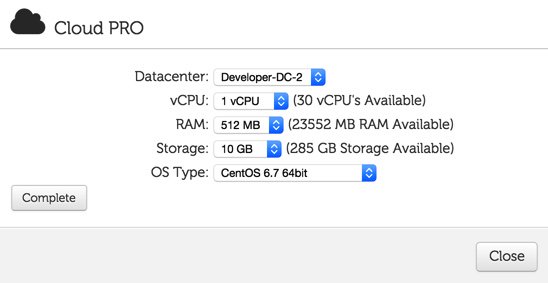
To create your first virtual machine, click on the CLOUDPRO button and click Add New Server. If you’ve only purchased the $17.50 CloudPRO 1 platform, then you’ll need all of the available resources shown in the pick list. Otherwise, choose 1 CPU, 512MB RAM, and 10GB storage for your first server. Leave CentOS 6.7 64bit selected as the OS Type and click Complete. Depending upon the type of special pricing that Cloud at Cost is offering when you sign up, the time to build your virtual machine can take anywhere from a minute to the better part of a day. We’ve learned to build new virtual machines at night, and they’re usually available for use by the next morning. Luckily, this slow performance does not impact existing virtual machines that already are running in their hosting facility.
Initial Configuration of Your CentOS 6 VM

With a little luck, your virtual machine soon will appear in your Cloud at Cost Management Portal and look something like what’s shown above. The red arrow points to the i button you’ll need to click to decipher the password for your new virtual machine. You’ll need both the IP address and the password for your new virtual machine in order to log into the server which is now up and running with a barebones CentOS 6.7 operating system. Note the yellow caution flag. That’s telling you that Cloud at Cost will automatically shut down your server in a week to save (them) computing resources. You can change the setting to keep your server running 24/7. Click Modify, Change Run Mode, and select Normal – Leave Powered On. Click Continue and OK to save your new settings.

Finally, you’ll want to change the Host Name for your server to something more descriptive than c7…cloudpro.92… Click the Modify button again and click Rename Server to make the change. Your management portal then will show the new server name as shown above.
Logging into Your CentOS 6 VM
In order to configure and manage your new CentOS 6 virtual machine, you’ll need to log into the new server using either SSH or, for Windows users, Putty. After installing Putty, run it and log in to the IP address of your VM with username root and the password you deciphered above. On a Mac, open a Terminal session and issue a command like this using the actual IP address of your new virtual machine:
ssh root@12.34.56.78
Before you do anything else, reset your root password to something very secure: passwd
Installing the LAMP Server Basics
Now we’re ready to build your LAMP server platform. We’ve chopped this up into lots of little steps so we can explain what’s happening as we go along. There’s nothing hard about this, but we want to document the process so you can repeat it at any time. As we go along, just cut-and-paste each clump of code into your SSH or Putty session and review the results to make sure nothing comes unglued. If something does, the beauty of virtual machines is you can delete them instantly within your management portal and just start over whenever you like. So here we go…
We’ll begin by permanently turning off SELINUX which causes more problems than it solves. The first command turns it off instantly. The second line assures that it’ll stay off whenever you reboot your virtual machine.
setenforce 0 sed -i s/SELINUX=enforcing/SELINUX=disabled/g /etc/selinux/config
First, let’s address a couple of CloudAtCost quirks that may cause problems down the road. CloudAtCost has a nasty habit of not cleaning up after itself with fresh installs. The net result is your root password gets reset every time you reboot.
killall plymouthd echo killall plymouthd >> /etc/rc.local rm -f /etc/rc3.d/S97*
Now let’s bring CentOS 6.7 up to current CentOS 6.8 specs and add a few important applications:
yum -y update yum -y install nano wget expect net-tools dialog git xz yum -y install kernel-headers yum -y install kernel-devel reboot
After reboot, log back in as root. Now we’ll set up your Apache web server and configure it to start whenever you reboot your server:
yum -y install httpd service httpd start chkconfig httpd on
Next, let’s set up your MySQL server, bring it on line, and make sure it restarts after server reboots. Unless you plan to add Asterisk® and FreePBX® to your server down the road, you’ll want to uncomment the two commands that begin with # by removing the # symbol and replacing new-password with a very secure password for your root user account in MySQL. Be sure to run the last command to secure your server. After logging in, the correct answers are n,Y,Y,Y,Y.
yum -y install mysql mysql-server service mysqld start chkconfig mysqld on #/usr/bin/mysqladmin -u root password 'new-password' #/usr/bin/mysqladmin -u root -p -h localhost.localdomain password 'new-password' mysql_secure_installation
Next, we’ll set up PHP and configure it to work with MySQL:
yum -y install php yum -y install php-mysql service httpd restart
Finally let’s get SendMail installed and configured. Insert your actual email address in the last line and send yourself a test message to be sure it’s working. Be sure to check your spam folder since the message will show a sender address of localhost which many email systems including Gmail automatically identify as spam.
yum -y install sendmail rpm -e postfix service sendmail restart yum -y install mailx echo "test" | mail -s testmessage youracctname@yourmailserver.com
Installing Supplemental Repositories
One of the beauties of Linux is not being totally dependent upon CentOS for all of your packaged applications. Let’s add a few other repositories that can be used when you need to add a special package that is not in the CentOS repository. Let’s start with EPEL. We’ll disable it by default and only use it when we need it.
yum -y install http://download.fedoraproject.org/pub/epel/6/x86_64/epel-release-6-8.noarch.rpm sed -i 's|enabled=1|enabled=0|' /etc/yum.repos.d/epel.repo
We actually need the EPEL repo to install Fail2Ban for monitoring of attacks on certain Linux services such as SSH:
yum --enablerepo=epel install fail2ban -y cd /etc wget http://incrediblepbx.com/fail2ban-lamp.tar.gz tar zxvf fail2ban-lamp.tar.gz
Another important repository is REMI. It is especially helpful if you decide to upgrade PHP from the default version 5.3 to one of the newer releases: 5.5 or 5.6. In this case, you’ll want to activate the specific repository to support the release you choose in /etc/yum.repos.d/remi-safe.repo.
yum -y install http://rpms.famillecollet.com/enterprise/remi-release-6.rpm sed -i 's|enabled=1|enabled=0|' /etc/yum.repos.d/remi-safe.repo
One final repository to have on hand is RPMForge, now renamed RepoForge. We’ll use it in a bit to install a dynamic DNS update utility which you actually won’t need at CloudAtCost since your server is assigned a static IP address. But it’s handy to have in the event you wish to assign a free FQDN to your server anyway.
yum -y install http://incrediblepbx.com/rpmforge-release-0.5.3-1.el6.rf.x86_64.rpm sed -i 's|enabled = 1|enabled = 0|' /etc/yum.repos.d/rpmforge.repo
Country Blocking with IPSET
We’ll use the EPEL repo to install ipset, a terrific addition to the IPtables Linux firewall that lets you quickly block entire countries from accessing your server:
yum --enablerepo=epel install ipset -y
Next, we’ll add a sample script that documents how the country blocking mechanism works with ipset. For a complete list of countries that can be blocked, go here. If you need a decoder badge to match abbreviations against country names, you’ll find it here. To add other countries, simply edit the shell script and clone lines 4-7 using the names of the countries and country zone files that you wish to add. Be sure to insert the new lines before the commands to restart iptables and fail2ban. This script will need to be run each time your server reboots and before IPtables is brought on line. We’ll handle that a little later.
echo "#\\!/bin/bash" > /etc/block-china.sh echo " " >> /etc/block-china.sh echo "cd /etc" >> /etc/block-china.sh echo "ipset -N china hash:net" >> /etc/block-china.sh echo "rm cn.zone" >> /etc/block-china.sh echo "wget -P . http://www.ipdeny.com/ipblocks/data/countries/cn.zone" >> /etc/block-china.sh echo "for i in \$(cat /etc/cn.zone ); do ipset -A china \$i; done" >> /etc/block-china.sh echo "service iptables restart" >> /etc/block-china.sh echo "service fail2ban restart" >> /etc/block-china.sh sed -i 's|\\\\||' /etc/block-china.sh chmod +x /etc/block-china.sh
Adding a Few Handy Utilities
If you’re like us, you’ll want to test the speed of your Internet connection from time to time. Let’s install a free script that you can run at any time by logging into your server as root and issuing the command: /root/speedtest.py. Here were our results from last year. Running speedtest on a new server we built today showed a vast improvement in performance. Downloads were over ten times as fast, and upload speeds more than tripled. In fact, we now are using two CloudAtCost servers to host the old PIAF3 repositories.
cd /root wget https://raw.githubusercontent.com/sivel/speedtest-cli/master/speedtest.py chmod +x speedtest.py

Next, let’s put in place a simple status display which will quickly tell you what’s running and what’s not. We’ve borrowed some GPL code from Incredible PBX to help you out. Run status-lamp at any time for a snapshot of your server.
cd /usr/local/sbin wget http://incrediblepbx.com/status-lamp.tar.gz tar zxvf status-lamp.tar.gz rm -f status-lamp.tar.gz sed -i 's|myip.pbxinaflash.com|myip.incrediblepbx.com|' /usr/local/sbin/status-lamp

Now we’ll put the Linux Swiss Army Knife in place. It’s called WebMin, and it provides a GUI to configure almost everything in Linux. Pick up a good WebMin book from your public library to get started. Once installed, you access WebMin from your browser at the IP address of your server on the default port of 10000: https://serverIPaddress:10000. It’s probably a good idea to change this port number and the commented out line shows how to do it with the new port being 9001 in the example. The way in which we typically configure the Linux firewall will block all access to WebMin except from an IP address which you have whitelisted, e.g. your home computer’s public IP address.
cd /root yum -y install perl perl-Net-SSLeay openssl perl-IO-Tty yum -y install http://prdownloads.sourceforge.net/webadmin/webmin-1.831-1.noarch.rpm #sed -i 's|10000|9001|g' /etc/webmin/miniserv.conf service webmin restart chkconfig webmin on
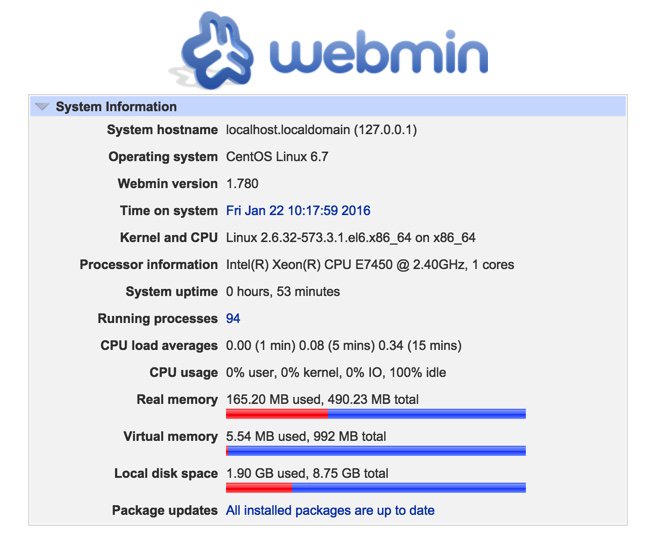
Configuring the Linux IPtables Firewall
RULE #1: DON’T BUILD SERVERS EXPOSED TO THE INTERNET WITHOUT SECURITY!
As installed by CloudAtCost, your server provides ping and SSH access from a remote computer and nothing else. The good news: it’s pretty safe. The bad news: it can’t do anything useful for anybody because all web access to the server is blocked. We want to fix that, tighten up SSH access to restrict it to your IP address, and deploy country blocking to show you how.
As we implement the firewall changes, you need to be extremely careful in your typing so that you don’t accidentally lock yourself out of your own server. A typo in an IP address is all it takes. The good news is that, if you do lock yourself out, you still can gain access via the CloudAtCost Management Portal by clicking the Console button of your virtual machine. Because the console is on the physical machine and the lo interface is whitelisted, you can log in and disable the firewall temporarily: service iptables stop. Then fix the typo and restart the firewall: service iptables start.
First, let’s download the new IPtables config file into your root folder and take a look at it.
cd /root wget http://incrediblepbx.com/iptables-lamp.tar.gz tar zxvf iptables-lamp.tar.gz
Now edit the /root/iptables-lamp file by issuing the command: nano -w /root/iptables-lamp
You can scroll up and down through the file with Ctl-V and Ctl-Y. Cursor keys work as well. Once you make changes, save your work: Ctl-X, Y, ENTER. You’re now an expert with the nano text editor, an absolutely essential Linux tool.
Here’s what that file actually looks like:
*filter :INPUT DROP [0:0] :FORWARD ACCEPT [0:0] :OUTPUT ACCEPT [0:0] -A INPUT -p tcp -m tcp --tcp-flags ACK ACK -j ACCEPT -A INPUT -m state --state ESTABLISHED,RELATED -j ACCEPT -A INPUT -p icmp -j DROP -A INPUT -i lo -j ACCEPT -A INPUT -p tcp ! --syn -m state --state NEW -j DROP -A INPUT -m state --state INVALID -j DROP -A INPUT -p tcp -m tcp --tcp-flags FIN,SYN,RST,PSH,ACK,URG NONE -j DROP -A INPUT -p tcp -m tcp --tcp-flags SYN,FIN SYN,FIN -j DROP -A INPUT -p tcp -m tcp --tcp-flags SYN,RST SYN,RST -j DROP -A INPUT -p tcp -m tcp --tcp-flags FIN,RST FIN,RST -j DROP -A INPUT -p tcp -m tcp --tcp-flags ACK,FIN FIN -j DROP -A INPUT -p tcp -m tcp --tcp-flags ACK,URG URG -j DROP -A INPUT -p tcp -m set --match-set china src -j DROP -A INPUT -p udp -m udp --dport 53 -j ACCEPT -A INPUT -p tcp -m tcp --dport 53 -j ACCEPT -A INPUT -p tcp -m tcp --dport 113 -j ACCEPT -A INPUT -p udp -m udp --dport 123 -j ACCEPT -A INPUT -p tcp -m tcp --dport 123 -j ACCEPT -A INPUT -m state --state NEW -m tcp -p tcp --dport 22 -j ACCEPT #-A INPUT -s 12.34.56.78 -j ACCEPT #-A INPUT -s yourFQDN.dyndns.org -j ACCEPT -A INPUT -p tcp -m tcp --dport 80 -j ACCEPT -A INPUT -j REJECT --reject-with icmp-host-prohibited -A FORWARD -j REJECT --reject-with icmp-host-prohibited COMMIT
Reminder: If you add another country to your block-china script, don’t forget to add a corresponding new country entry to your iptables file. See line 17 above that includes the word "china" for the syntax. There’s nothing much else to tweak except the two commented out (brown) lines that begin with #. First, remove the # symbol by moving the cursor to the right of the first one and hitting the backspace/delete key on your keyboard. Replace 12.34.56.78 with the public IP address of the computer from which you will be accessing your virtual machine. If you need multiple entries for multiple computers at different addresses, clone the line by pressing Ctrl-K and then Ctrl-U twice. Yes, we know. Some folks IP addresses change from time to time. In the next section, we’ll show you how to set up a Dynamic DNS entry with a utility that will keep track of your current IP address. In this case, uncomment the second commented line and replace yourFQDN.dyndns.org with your dynamic DNS address. Be very careful to assure that your FQDN is always on line. If the firewall cannot verify your DNS entry when it starts, the IPtables firewall will not start which means your server will be left unprotected. HINT: IP addresses are much safer because they are never verified.
Once you have your whitelisted addresses configured, comment out the port 22 line to keep the bad guys from trying to break into your server with SSH. Then save the file: Ctl-X, Y, ENTER. Next, issue the following commands to copy everything into place and restart the firewall.
mv /etc/sysconfig/iptables /etc/sysconfig/iptables.orig cp -p /root/iptables-lamp /etc/sysconfig/iptables echo "/etc/block-china.sh" >> /etc/rc.local /etc/block-china.sh
Always, always, always check to be sure your firewall is functioning: iptables -nL. If you don’t see your desktop computer’s public IP address near the end of the listing, then the firewall is dead. status-lamp should also show IPtables down. Check for an error message which will tell you the problematic line so you can correct it.
Implementing Dynamic DNS Service
There are a number of free and paid Dynamic DNS providers. The way this works is you choose a fully-qualified domain name (FQDN) to identify your computer. Then you run a dynamic DNS update utility periodically from that computer. It reports back the current public IP address of your computer and your provider updates the IP address assigned to your FQDN if it has changed. In addition to supporting sites with ever changing IP addresses, it also allows you to permanently assign an FQDN to your computer or server so that it can be accessed without using a cryptic IP address.
If that computer happens to be an Incredible PBX server or a LAMP server that you’ve set up using this tutorial, then the following will get the DNS client update utility loaded using the RPM Forge repository that we previously installed:
yum --enablerepo=rpmforge install ddclient -y
Similar DNS update clients are available for Windows, Mac OS X, and many residential routers. Then it’s just a matter of plugging in the credentials for your dynamic DNS provider and your FQDN. In the case of the CentOS client, the config file is /etc/ddclient/ddclient.conf. Now reboot your server and pick up a good book on Linux to begin your adventure.
Now For Some Fun…
First, let’s check things out and make sure everything is working as it should. With your favorite web browser, visit the IP address of your new server. You should see the default Apache page:

Next, let’s be sure that PHP is working as it should. While still logged into your server as root using SSH or Putty, issue the following commands and make up some file name to replace test4567 in both lines. Be sure to keep the .php file name extension. Note to gurus: Yes, we know the second line below is unnecessary if you remove the space after the less than symbol in the first line. Unfortunately, WordPress forces the space into the display which left us no alternative.
echo "< ?php phpinfo(); ?>" > /var/www/html/test4567.php sed -i 's|< |<|' /var/www/html/test4567.php
Now jump back to your web browser and access the new page you just created using the IP address of your server and the file name you made up: http://12.34.56.78/test4567.php
The PHPinfo listing will tell you everything you ever wanted to know about your web server setup including all of the PHP functions that have been enabled. That's why you want an obscure file name for the page. You obviously don't want to share that information with every bad guy on the planet. Remember. This is a public-facing web site that anyone on the Internet can access if they know or guess your IP address.
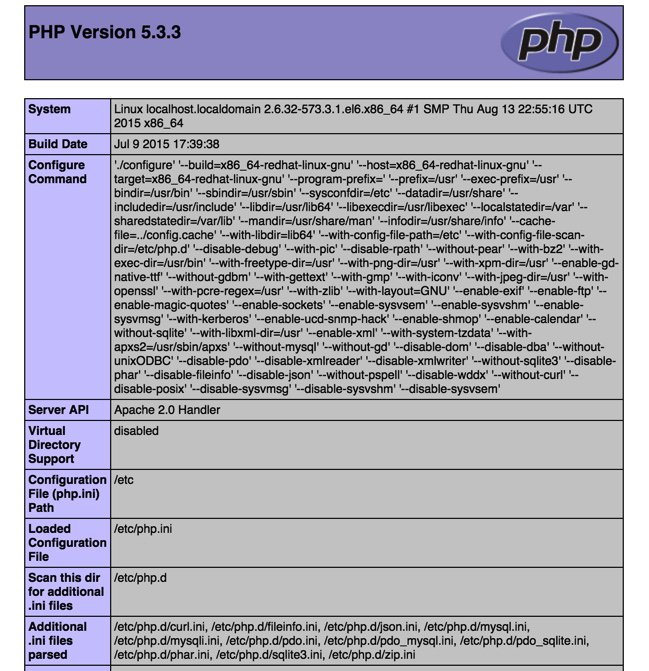
When you're ready to set up your own web site, just name it index.php and store the file in the /var/www/html directory of your server. In the meantime, issuing the following command will assure that anyone accessing your site gets a blank page until you're ready to begin your adventure:
echo " " > /var/www/html/index.php
Ready to learn PHP programming? There's no shortage of books to get you started.
Adding WordPress to Your LAMP Server
Where to begin with WordPress? What used to be a simple platform for bloggers has morphed into an all-purpose tool that makes building virtually any type of web site child's play. If you want to see what's possible, take a look at the templates and sample sites shown on WPZOOM. Unless you're an art major and savvy web designer, this will be the best $70 you ever spent. One of these templates will have your site up and running in minutes once we put the WordPress pieces in place. For the big spenders, $149 will give you access to over 50 gorgeous templates which you can download and use to your heart's content on multiple sites. And, no, your sites don't blow up after a year. You just can't download any additional templates or updates unless you renew your subscription. The other alternative is choose from thousands of templates that are provided across the Internet as well as in the WordPress application itself.
WordPress templates run the gamut from blogs to newsletters to photographer sites to e-commerce to business portfolios to video to travel to magazines to newspapers to education to food to recipes to restaurants and more. Whew! There literally is nothing you can't put together in minutes using a WordPress template. But, before you can begin, we need to get WordPress installed on your server. This is optional, of course. And, if you follow along and add WordPress, we've set it up in such a way that WordPress becomes the primary application for your site. Stated differently, when people use a browser to access your site, your WordPress template will immediately display. When we finish the basic WordPress setup and once you upload an image or two, you'll have a site that looks something like this:

Before you begin, we strongly recommend that you acquire a domain for your site if you plan to use it for anything but experimentation. The reason is because it can be complicated to migrate a WordPress site from one location to another.1 Once you've acquired your domain, point the domain to the IP address of your new server. With a dirt cheap registrar such as Omnis.com, it's easy:
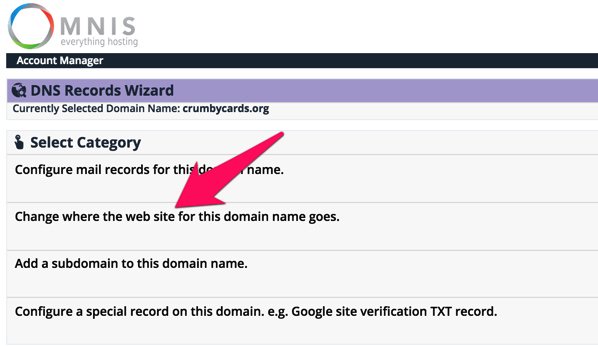
Now let's get started. To begin, we need to load the WordPress application onto your server:
cd /root mkdir wordpress cd wordpress wget http://wordpress.org/latest.tar.gz tar -xvzf latest.tar.gz -C /var/www/html
Next, we'll configure MySQL to support WordPress. We're assuming that you have NOT already created root passwords for MySQL. If you have, you'll need to add -pYourPassword to the various commands below immediately after root. There is no space between -p and your root password. Also edit the first line and make up a new password (replacing XYZ below) for the wordpress user account that will manage WordPress on your server before you cut and paste the code:
mysql -u root -e 'CREATE USER wordpress@localhost IDENTIFIED BY "XYZ";' mysql -u root -e 'CREATE DATABASE wordpress;' mysql -u root -e 'GRANT ALL ON wordpress.* TO wordpress@localhost;' mysql -u root -e 'FLUSH PRIVILEGES;'
Next, we need to configure WordPress with your new MySQL credentials. Before you cut and paste, replace XYZ in the fourth line with the password you assigned in the preceding MySQL step:
cp /var/www/html/wordpress/wp-config-sample.php /var/www/html/wordpress/wp-config.php sed -i 's|database_name_here|wordpress|' /var/www/html/wordpress/wp-config.php sed -i 's|username_here|wordpress|' /var/www/html/wordpress/wp-config.php sed -i 's|password_here|XYZ|' /var/www/html/wordpress/wp-config.php chown -R apache:apache /var/www/html/wordpress
Before you forget, take a moment and create a very secure password for your MySQL root user accounts. Here are the commands. Just replace new-password with your new password before you cut and paste. Note that you also will be prompted for this password when you execute the second command because you will now have a root user password in place from executing the first command.
/usr/bin/mysqladmin -u root password 'new-password' /usr/bin/mysqladmin -u root -p -h localhost.localdomain password 'new-password'
Finally, we need to modify your Apache web server to support WordPress as the primary application. Be sure to enter your actual email address in the third line before you cut and paste the code below:
echo " " >> /etc/httpd/conf/httpd.conf echo "" >> /etc/httpd/conf/httpd.conf echo 'ServerAdmin somebody@somedomain.com' >> /etc/httpd/conf/httpd.conf echo "DocumentRoot /var/www/html/wordpress" >> /etc/httpd/conf/httpd.conf echo "ServerName wordpress" >> /etc/httpd/conf/httpd.conf echo "ErrorLog /var/log/httpd/wordpress-error-log" >> /etc/httpd/conf/httpd.conf echo "CustomLog /var/log/httpd/wordpress-acces-log common" >> /etc/httpd/conf/httpd.conf echo " " >> /etc/httpd/conf/httpd.conf echo " " >> /etc/httpd/conf/httpd.conf service httpd restart
That should do it. Open a browser and navigate to the IP address of your server. You should be greeted with the following form. Fill in the blanks as desired. The account you're setting up will be the credentials you use to add and modify content on your WordPress site when you click Log In (as shown above). Make the username obscure and the password even more so. Remember, it's a public web site accessible worldwide! When you click Install WordPress, you'll be off to the races.
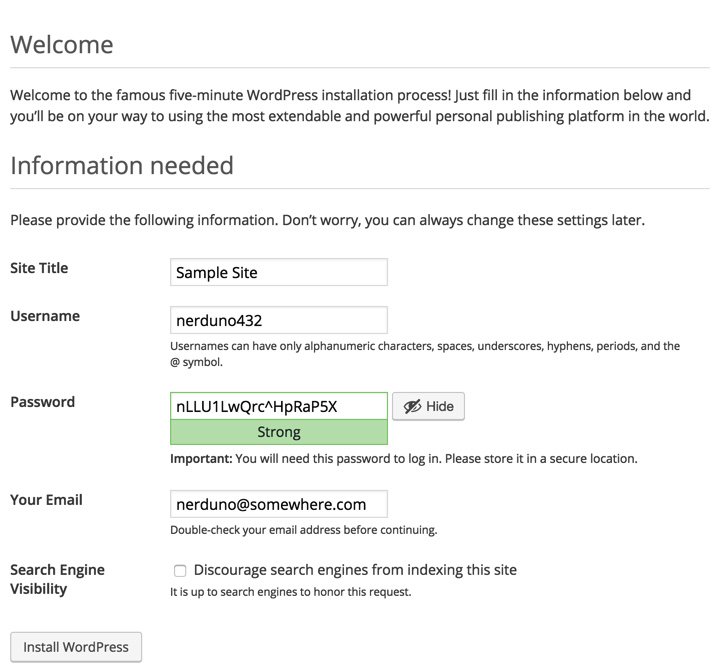
After your server whirs away for a minute or two, you will be greeted with the WordPress login prompt. With the username and password you entered above, you'll be ready to start configuring your WordPress site.
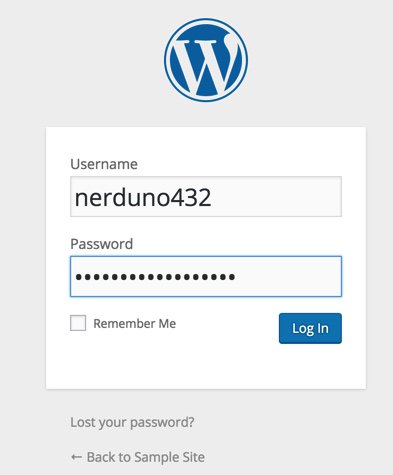
Once you're logged in, navigate to Appearance -> Themes and click Add New Theme. There's you will find literally hundreds of free WordPress templates that can be installed in a matter of seconds if WPZOOM is too rich for your blood. For a terrific all-purpose (free) theme, try Atahualpa. We'll leave our actual demo site running for a bit in case you want to explore and check out its performance. Installing and configuring the new theme took less than a minute:

A Final Word to the Wise. WordPress is relatively secure but new vulnerabilities are discovered regularly. Keep your templates, plug-ins, AND the WordPress application up to date at all times! The WordFence plug-in is a must-have. And we strongly recommend adding the following lines to your WordPress config file which then will let WordPress update everything automatically. Microsoft has given automatic updates a bad name, but in the case of WordPress, they work well.
echo "define('WP_AUTO_UPDATE_CORE', true);" >> /var/www/html/wordpress/wp-config.php
echo "add_filter( 'auto_update_plugin', '__return_true' );" >> /var/www/html/wordpress/wp-config.php
echo "add_filter( 'auto_update_theme', '__return_true' );" >> /var/www/html/wordpress/wp-config.php

Building a 3CX Server in the Cloud
Now we're ready for our second cloud project. In less than 10 minutes, we're going to build a free 3CX commercial PBX using the remaining Cloud resources from our $35 purchase. To create your second virtual machine, click on the CLOUDPRO button in the CloudAtCost control panel and then click Add New Server. Choose 1 CPU, 512MB RAM, and 10GB storage for your second server. Choose Debian 8 64bit as the OS Type and click Complete.
Obtain a free license key for 3CX. Next, log in to your new Debian server as root using SSH or Putty and issue these commands. We'll begin by changing your root password.
NOTE: What appears as the fourth line below needs to be added to line #3!
passwd wget -O- http://downloads.3cx.com/downloads/3cxpbx/public.key | apt-key add - echo "deb http://downloads.3cx.com/downloads/3cxpbx/ /" | tee /etc/apt/sources.list.d/3cxpbx.list apt-get update rm -f /zang-debian.sh apt-get -y install 3cxpbx apt-get -y install sendmail sendmail-bin
When the initial setup finishes, choose the Web Interface Wizard and complete the install using your favorite web browser. Enter your 3CX license key when prompted. Make up a very secure Username and Password to access your 3CX portal. Specify that your IP address is Dynamic when prompted (even though it isn't). This tells 3CX to generate an FQDN for your server. Accept the default ports for HTTP (5000) and HTTPS (5001) access to your server. We recommend choosing 4-digit extensions numbers so you'll be ready for next week's project interconnecting your 3CX server to a Raspberry Pi for the best of both worlds. While logged into the 3CX management portal, adjust Settings → Email to Mail Server → 127.0.0.1 and Reply to → noreply@YourActual3CX-FQDN. Leave the other settings blank and click TEST then OK. Set up a SIP trunk with inbound and outbound call routes. Now download your favorite 3CX smartphone client, send yourself the Welcome Email for your default extension, and start calling. It really doesn't get much easier in the VoIP World. Come join the PIAF Forum if you need a helping hand!
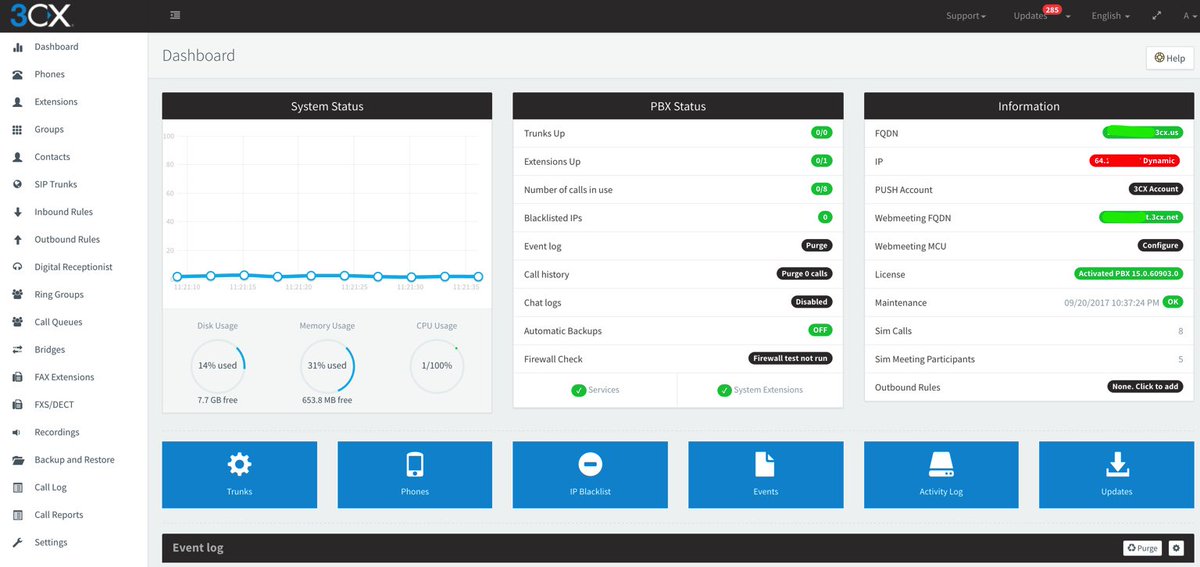
Free Calling in the U.S. and Canada with PIAF5. We know our more frugal U.S. residents are wondering if there's a way to make free calls even with 3CX. You didn't really think there would be a release of PBX in a Flash without Google Voice support, did you? It's easy using the Simonics SIP to Google Voice gateway service. Setup time is about a minute, and the one-time cost is $4.99 using this Nerd Vittles link. Setup instructions for the 3CX side are straight-forward as well, and we've documented the procedure on the PIAF Forum.

Free Calling Worldwide with SIP URIs. There's another free calling option as well. PIAF5 and 3CX support worldwide SIP URI calling at no cost. As part of the PIAF5 install procedure, 3CX registers an FQDN for you with one of the 3CX domains if you indicate that your server has a dynamic IP address. Unless you really know what you're doing with DNS, it's a good idea to tell 3CX you have a dynamic IP address whether you do or not. Here's why. Once you have an assigned FQDN in the 3CX universe, one very slick feature is the ease with which you can publish a SIP URI address for any or all of your 3CX extensions thereby allowing PIAF5 users to receive calls from any SIP client worldwide at no cost. Setup takes less than a minute. It's as easy as 1-2-3. Here's how:
1. Login to the 3CX GUI and go to Settings → Network → FQDN. Tick "Allow calls from/to external SIP URIs" and make note of your FQDN, e.g. mypiaf5server.3cx.us. Click OK.
2. For an extension to enable (e.g. 001), go to Extensions → Edit 001 → Options → SIP ID and create any desired SIP URI alias for this extension, e.g. billybob. Click OK.
3. Anyone with a SIP client anywhere worldwide can now call extension 001 using SIP URI: billybob@mypiaf5server.3cx.us.
Special Thanks: Our special tip of the hat goes to a few web sites that we found helpful in putting this article together especially Unixmen and Matt Wilcox & friends and Programming-Review.
Originally published: Tuesday, February 28, 2017
9 Countries Have Never Visited Nerd Vittles. Got a Friend in Any of Them https://t.co/wMfmlhiQ9y #asterisk #freepbx pic.twitter.com/TPFGZbqWB6
— Ward Mundy (@NerdUno) April 22, 2016

Need help with Asterisk? Visit the PBX in a Flash Forum.
Special Thanks to Our Generous Sponsors
FULL DISCLOSURE: ClearlyIP, Skyetel, Vitelity, DigitalOcean, Vultr, VoIP.ms, 3CX, Sangoma, TelecomsXchange and VitalPBX have provided financial support to Nerd Vittles and our open source projects through advertising, referral revenue, and/or merchandise. As an Amazon Associate and Best Buy Affiliate, we also earn from qualifying purchases. We’ve chosen these providers not the other way around. Our decisions are based upon their corporate reputation and the quality of their offerings and pricing. Our recommendations regarding technology are reached without regard to financial compensation except in situations in which comparable products at comparable pricing are available from multiple sources. In this limited case, we support our sponsors because our sponsors support us.
 BOGO Bonaza: Enjoy state-of-the-art VoIP service with a $10 credit and half-price SIP service on up to $500 of Skyetel trunking with free number porting when you fund your Skyetel account. No limits on number of simultaneous calls. Quadruple data center redundancy. $25 monthly minimum spend required. Tutorial and sign up details are here.
BOGO Bonaza: Enjoy state-of-the-art VoIP service with a $10 credit and half-price SIP service on up to $500 of Skyetel trunking with free number porting when you fund your Skyetel account. No limits on number of simultaneous calls. Quadruple data center redundancy. $25 monthly minimum spend required. Tutorial and sign up details are here.
 The lynchpin of Incredible PBX 2020 and beyond is ClearlyIP components which bring management of FreePBX modules and SIP phone integration to a level never before available with any other Asterisk distribution. And now you can configure and reconfigure your new Incredible PBX phones from the convenience of the Incredible PBX GUI.
The lynchpin of Incredible PBX 2020 and beyond is ClearlyIP components which bring management of FreePBX modules and SIP phone integration to a level never before available with any other Asterisk distribution. And now you can configure and reconfigure your new Incredible PBX phones from the convenience of the Incredible PBX GUI.
 VitalPBX is perhaps the fastest-growing PBX offering based upon Asterisk with an installed presence in more than 100 countries worldwide. VitalPBX has generously provided a customized White Label version of Incredible PBX tailored for use with all Incredible PBX and VitalPBX custom applications. Follow this link for a free test drive!
VitalPBX is perhaps the fastest-growing PBX offering based upon Asterisk with an installed presence in more than 100 countries worldwide. VitalPBX has generously provided a customized White Label version of Incredible PBX tailored for use with all Incredible PBX and VitalPBX custom applications. Follow this link for a free test drive!
 Special Thanks to Vitelity. Vitelity is now Voyant Communications and has halted new registrations for the time being. Our special thanks to Vitelity for their unwavering financial support over many years and to the many Nerd Vittles readers who continue to enjoy the benefits of their service offerings. We will keep everyone posted on further developments.
Special Thanks to Vitelity. Vitelity is now Voyant Communications and has halted new registrations for the time being. Our special thanks to Vitelity for their unwavering financial support over many years and to the many Nerd Vittles readers who continue to enjoy the benefits of their service offerings. We will keep everyone posted on further developments.
Some Recent Nerd Vittles Articles of Interest...
- Should you ever have to migrate your WordPress site from one domain to another, here are two helpful tools to consider: the Automatic Domain Name Changer Plugin and our favorite: WordPress-Domain-Changer. [↩]
Introducing a New WhiteList Security Model for Wazo

Today we’re pleased to introduce a new state-of-the-art Travelin’ Man 3 firewall implementation for 2017. Five years ago, we developed a new security model for Asterisk® servers that whitelisted those needing access while blocking everyone else. The design was simple. You can’t attack what you can’t see. Three years ago, we made Travelin’ Man 3 more flexible for remote users with the addition of PortKnocker, a terrific tool providing temporary remote server access using a random three-number code. Today’s release further streamlines the firewall management process. Trusted users can permanently whitelist new IP addresses from anywhere using any PC or smartphone.

Travelin’ Man 3 Overview
If you’re new to Travelin’ Man 3 and the Linux IPtables firewall, here’s a quick overview. IPtables is a software-based firewall that is integrated into the Linux kernel. It consists of rules that define which IP packets hitting your server are allowed through the gate. The whitelist methodology behind Travelin’ Man 3 works like this. We predefine a list of trusted VoIP providers that get SIP and IAX access to your server so that you can easily set up trunks for incoming and outgoing calls. Then, as part of the Incredible PBX installation procedure, we whitelist all non-routable IP addresses as well as the public IP addresses of your server and the PC from which you installed Incredible PBX. Nobody else can even see your server on the Internet.
New Travelin’ Man 3 Design
With today’s new Travelin’ Man 3 design, you can whitelist additional IP addresses in several ways. First, as the administrator, you can log into your server as root and whitelist any IP address using the add-ip script in the /root folder. If a fully-qualified domain name (FQDN) is associated with the IP address to be whitelisted, the administrator can use the add-fqdn script to add the FQDN. If the FQDN points to a dynamic IP address that is refreshed using a dynamic IP update service, then Travelin’ Man 3 will refresh the firewall at 10-minute intervals to assure that remote users always have access to the server. This differs from previous releases of Travelin’ Man 3 that required a manual entry in /root/ipchecker to enable automatic refreshes.
A third method for permanently adding whitelist entries to your firewall is now provided using PortKnocker which is an integral component of Incredible PBX. By providing your PortKnocker credentials (/root/knock.FAQ) to any user, that user can easily gain one-click permanent access to the server using either the NMAP utility from a remote computer or the iOS PortKnock or Android DroidKnocker apps available for smartphones. As in previous releases of Travelin’ Man 3, an administrator can remove whitelist entries using del-acct utility in the /root folder. All admin and user-generated whitelist entries are stored in /root with a file extension of .iptables. Those generated using PortKnocker are automatically assigned a filename consisting of the timestamp associated with the time at which the whitelist entry was created. IMPORTANT: To authorize PortKnocker to permanently add IP addresses to your firewall, there is an activation step. Log into your server as root and issue the following command: iptables-knock activate
As part of the new implementation of Travelin’ Man 3 for the Incredible PBX for Wazo platform (only!), we’ve also reworked the firewall design a bit. There were several serious limitations in the original IPtables implementation of TM3. First, while IPtables allowed FQDN entries in its main configuration file, if one or more of those domains was off-line when IPtables was started or restarted, the entire firewall came crashing down leaving your server unprotected. In prior implementations, we avoided catastrophe by always using our iptables-restart utility to start and restart IPtables. This utility automatically tested for firewall failures and removed FQDN entries that caused the problems. A second limitation in the original Travelin’ Man 3 design involved an administrator who inadvertently used the iptables save command to modify an existing IPtables setup. Whenever this command is executed, IPtables immediately rewrites all FQDN entries in its configuration by converting them to IP addresses thereby eliminating the ability of the firewall to account for dynamic IP address changes occurring thereafter. Perhaps the most dangerous limitation occurred where your server’s network connection was not yet active when IPtables was started. If your configuration included FQDN entries, this would always cause IPtables startup to fail since FQDNs are all tested for availability as part of the initialization process. With Incredible PBX implementations, we have designed some safeguards into the network startup process to minimize this risk, but it would still be a problem if an administrator happened to notice that a network cable was unplugged and chose to plug it in after the server had already booted. Yes, the network would come on line. No, the IPtables firewall would not if there were FQDN entries in the config causing an IPtables startup failure.
Here’s a quick summary of the new IPtables design. First, there are never FQDN entries in the main IPtables config file, /etc/iptables/rules.v4. Instead, all custom whitelist entries now are generated in /usr/local/sbin/iptables-custom. The startup and restart procedure with iptables-restart now works like this. First, IPtables is started with the rules.v4 rules. Next, Fail2Ban is restarted as a second layer of protection for your server. Finally, the custom rules including all of your whitelisted IP addresses and FQDNs are started by running iptables-custom. If individual custom rules fail, they simply fail. They won’t bring down the firewall or Fail2Ban. Custom rules in iptables-custom look like this:
/sbin/iptables -A INPUT -s yourFQDN.dyndns.org -j ACCEPT
It should be noted that, if an administrator, inadvertently restarts the firewall without using the iptables-restart script, the consequences will be that the custom whitelist rules will not be loaded and Fail2Ban may not function properly. This shouldn’t be a problem because those with whitelisted remote phones will soon be calling with complaints that their phones are off-line. 🙂
As with all servers, your Incredible PBX server is only secure as long as you have no rotten apples in the employee pool. So, yes, there may come a time when it becomes necessary to modify your 3-number PortKnocker credentials to block an employee who has been terminated. The three steps to do this would be the following. First, edit /etc/knockd.conf and change the 3 port addresses in the sequence entry. Second, restart PortKnocker on your server: /etc/init.d/knockd restart. Third, modify /root/knock.FAQ to reflect your newly assigned ports and redistribute the file to remote employees.
Ready to get started? Hop over to the latest Incredible PBX for Wazo tutorial and fire up a new server. If you have an existing XiVO or Wazo server and you’d like to implement the new Travelin’ Man 3 design, here’s a tutorial to get you started. Enjoy!
Published: Monday, February 20, 2017

Need help with Asterisk? Visit the PBX in a Flash Forum.
Special Thanks to Our Generous Sponsors
FULL DISCLOSURE: ClearlyIP, Skyetel, Vitelity, DigitalOcean, Vultr, VoIP.ms, 3CX, Sangoma, TelecomsXchange and VitalPBX have provided financial support to Nerd Vittles and our open source projects through advertising, referral revenue, and/or merchandise. As an Amazon Associate and Best Buy Affiliate, we also earn from qualifying purchases. We’ve chosen these providers not the other way around. Our decisions are based upon their corporate reputation and the quality of their offerings and pricing. Our recommendations regarding technology are reached without regard to financial compensation except in situations in which comparable products at comparable pricing are available from multiple sources. In this limited case, we support our sponsors because our sponsors support us.
 BOGO Bonaza: Enjoy state-of-the-art VoIP service with a $10 credit and half-price SIP service on up to $500 of Skyetel trunking with free number porting when you fund your Skyetel account. No limits on number of simultaneous calls. Quadruple data center redundancy. $25 monthly minimum spend required. Tutorial and sign up details are here.
BOGO Bonaza: Enjoy state-of-the-art VoIP service with a $10 credit and half-price SIP service on up to $500 of Skyetel trunking with free number porting when you fund your Skyetel account. No limits on number of simultaneous calls. Quadruple data center redundancy. $25 monthly minimum spend required. Tutorial and sign up details are here.
 The lynchpin of Incredible PBX 2020 and beyond is ClearlyIP components which bring management of FreePBX modules and SIP phone integration to a level never before available with any other Asterisk distribution. And now you can configure and reconfigure your new Incredible PBX phones from the convenience of the Incredible PBX GUI.
The lynchpin of Incredible PBX 2020 and beyond is ClearlyIP components which bring management of FreePBX modules and SIP phone integration to a level never before available with any other Asterisk distribution. And now you can configure and reconfigure your new Incredible PBX phones from the convenience of the Incredible PBX GUI.
 VitalPBX is perhaps the fastest-growing PBX offering based upon Asterisk with an installed presence in more than 100 countries worldwide. VitalPBX has generously provided a customized White Label version of Incredible PBX tailored for use with all Incredible PBX and VitalPBX custom applications. Follow this link for a free test drive!
VitalPBX is perhaps the fastest-growing PBX offering based upon Asterisk with an installed presence in more than 100 countries worldwide. VitalPBX has generously provided a customized White Label version of Incredible PBX tailored for use with all Incredible PBX and VitalPBX custom applications. Follow this link for a free test drive!
 Special Thanks to Vitelity. Vitelity is now Voyant Communications and has halted new registrations for the time being. Our special thanks to Vitelity for their unwavering financial support over many years and to the many Nerd Vittles readers who continue to enjoy the benefits of their service offerings. We will keep everyone posted on further developments.
Special Thanks to Vitelity. Vitelity is now Voyant Communications and has halted new registrations for the time being. Our special thanks to Vitelity for their unwavering financial support over many years and to the many Nerd Vittles readers who continue to enjoy the benefits of their service offerings. We will keep everyone posted on further developments.
Some Recent Nerd Vittles Articles of Interest…


 JUST RELEASED: Visit the Incredible PBX Wiki
JUST RELEASED: Visit the Incredible PBX Wiki